It’s time for our Radeon RX 5700 XT and RX 5700 review. AMD's got us on a busy schedule having just tested the new 3rd-gen Ryzen parts, we're now ready to check out Navi before we go back and review the mainstream Ryzen 5 3600 CPU tomorrow, so plenty more hardware goodness to come.
AMD's latest Navi GPUs are built using TSMC's 7nm manufacturing process and because of this they're significantly smaller than the previous Radeon RX Vega 56 and 64 parts. When compared to Vega 10, Navi packs 18% fewer transistors, but is almost 50% smaller at 251mm2. Whereas Vega 64 featured 64 compute units and Vega 56, 56 compute units, the RX 5700 gets only 36 and the 5700 XT gets 40. However, this is somewhat of a meaningless comparison as the cores used in the Navi GPUs are very different to Vega's.
The peak single precision performance of the 5700 XT is down 23% compared to Vega 64 -- this is a more relevant metric for compute -- while the peak pixel fill-rate has been increased by 23%, and that’s what will make the 5700 XT a better gaming GPU.
AMD has also done away with HBM for the new parts and instead they feature 8GB of GDDR6 memory for a bandwidth of 448 GB/s using a 256-bit wide memory bus. This is about the same peak bandwidth of the new competing GeForce RTX 2060 Super and 2070 Super graphics cards.
Initially the Radeon 5700 XT was set to cost $450, but at the last minute AMD dropped that by $50 making it a $400 part (see, the Super effect). Meanwhile the RX 5700 was reduced by $30 ahead of launch taking it from $380 to $350. That's what a competitive GPU landscape looks like.
| Radeon RX 5700 XT | Radeon RX 5700 | Radeon RX Vega 64 | GeForce RTX 2070 Super | GeForce RTX 2060 Super | |
| Price (MSRP) | $400 | $350 | $500 | $500 | $400 |
| Architecture | RDNA 7nm TSMC | RDNA 7nm TSMC | GCN 5 14nm GF | Turing 12nm TSMC | Turing 12nm TSMC |
| Graphics core | 2560 SP | 2304 SP | 4096 SP | 2560 CUDA | 2176 CUDA |
| Peak SP Compute | 9.7 TFLOPs | 7.9 TFLOPS | 13.4 TFLOPs | 9.1 TFLOPS | 7.2 TLFOPS |
| Base clock | 1605 MHz | 1465 MHz | 1247 MHz | 1605 MHz | 1470 MHz |
| Game clock | 1755 MHz | 1625 MHz | N/A | N/A | N/A |
| Boost clock | 1905 MHz | 1725 MHz | 1546 MHz | 1770 MHz | 1650 MHz |
| Memory | 8GB 256-bit GDDR6 | 8GB 256-bit GDDR6 | 8GB 2048-bit HBM2 | 8GB 256-bit GDDR6 | 8GB 256-bit GDDR6 |
| Memory bandwidth | 448 GBps | 448 GBps | 484 GBps | 448 GBps | 448 GBps |
| TDP | 225 W | 185 W | 295 W | 215 W | 175 W |
AMD is claiming a 225 W board power rating for the 5700 XT and 185 W for the 5700, both lower than Vega 10. As for clock speeds, these can be a little misleading though at least AMD has specified a gaming clock. The boost clock is virtually meaningless as this frequency isn’t achieved beyond the first few seconds of gaming. So the gaming clock is a more accurate metric and we generally saw clock speeds around 50 MHz higher than what AMD claims, at least in our 21 degree test environment, though in more adverse scenarios the fan speed should simply ramp up to maintain clock speeds.
Navi also brings support for PCIe 4.0 which is nice on paper but for these particular GPUs it offers no tangible improvements over the 3.0 spec.
For testing we’ve used an Intel Core i9-9900K clocked at 5 GHz with 32GB of DDR4-3400 memory. The latest drivers available at the time of testing have been used and all this data is fresh for this review and collected in the past two weeks. We have tested 12 games before our usual performance breakdowns and cost per frame data.
Benchmarks
First up we have Battlefield V and right away we have some odd results. The Radeon RX 5700 XT is very impressive rendering 112 fps on average, but we also see an unusually low 1% performance. Whereas the 5700 XT is 11% faster than the RTX 2070 Super for the average frame rate, it was just 1% faster for the 1% low result. Gameplay was smooth and no stuttering was noticed but we'll have to see if this is something AMD can solve with a future driver or not.
We see the same thing with the standard 5700, although it matched the average frame rate of the 2070 Super, the 1% low result was well below that of the 2060 Super. Overall performance in-game was good, and the better news is this was the only title where we observed this kind of 1% low performance.
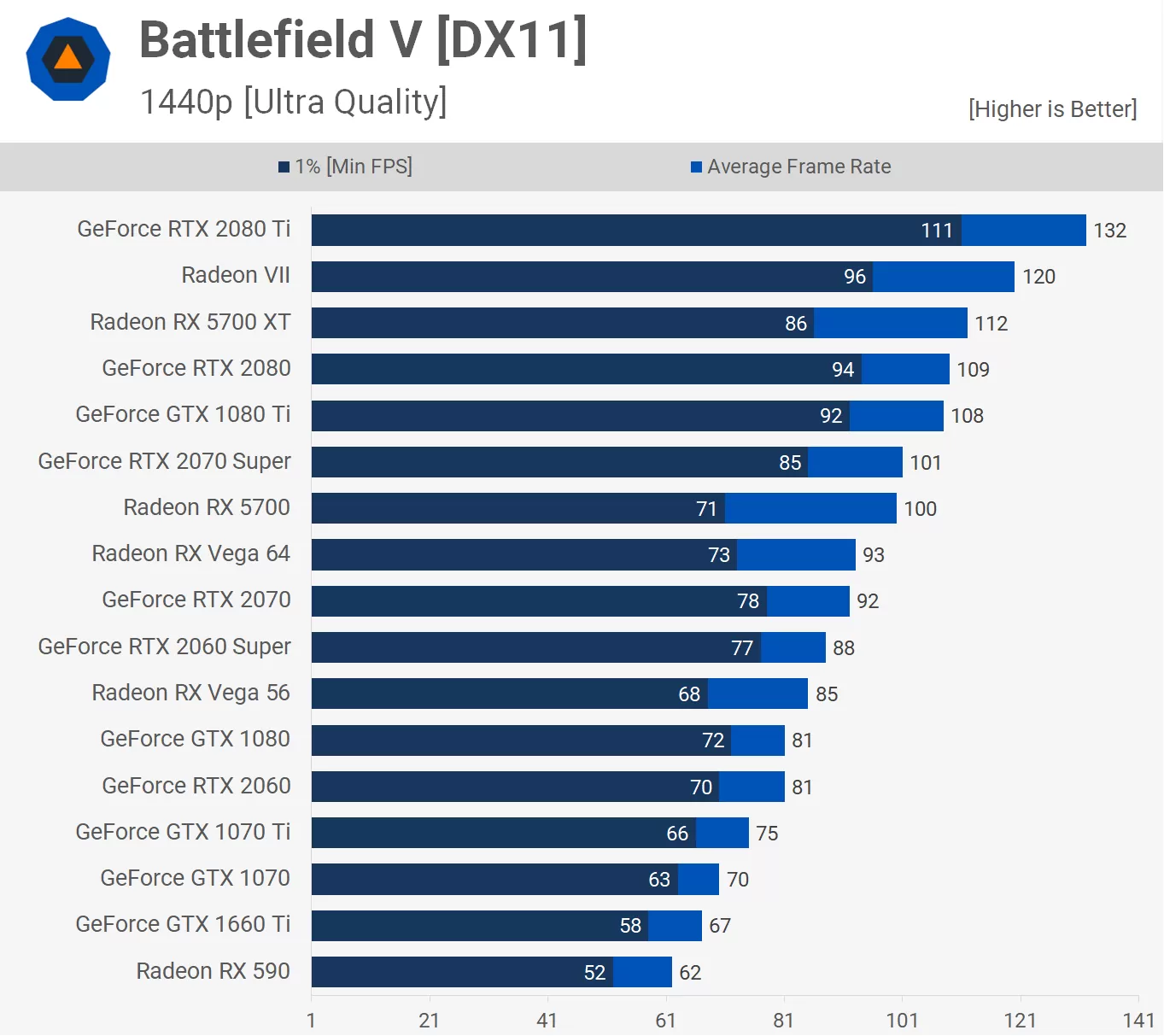
Frame rates in Rainbow Six Siege, for example, were very consistent, though here the RX 5700 XT fell short of matching the RTX 2070 Super. It did deliver RTX 2070-like performance and was 5% slower than the Radeon VII.
The RX 5700 was ~9% behind the RTX 2060 Super, though we're hoping to see more favorable results for AMD in the other games tested.
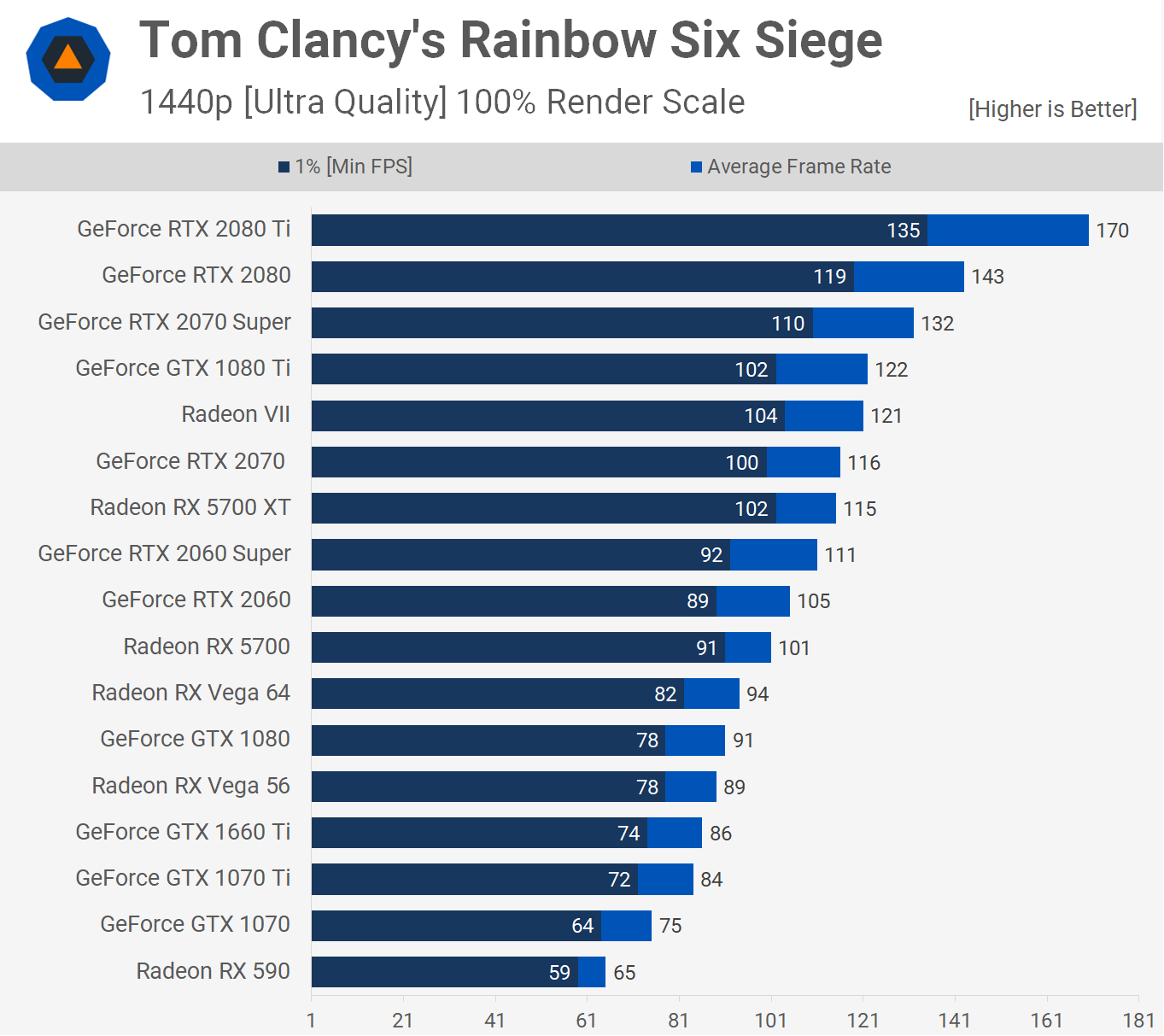
Now with Metro Exodus though. The margins are quite similar in this game, where the 5700 XT trailed the 2070 Super by an 11% margin, and the 5700 was 6% slower than the 2060 Super.
The Radeon VII was also 17% faster than the 5700 XT, though of course it is a much more expensive product.

Moving on to Resident Evil 2, we see fairly competitive results. The 5700 XT was 5% slower than the RTX 2070 Super while the 5700 was 4% slower than the 2060 Super. Although Nvidia enjoys a performance advantage, particularly after their Super boost, their graphics cards also cost more, so it will be interesting to see how they all compare in the cost per frame analysis at the end of this review.

Next up we have Shadow of the Tomb Raider and here the 5700 and 2060 Super are neck and neck. The 5700 XT didn’t do poorly, but it was 7% slower than the 2070 Super. It also costs 20% less.

Both new RX 5700 graphics cards were able to deliver highly playable performance in Fortnite at 1440p using the maximum image quality settings, but as we’ve said in the past this isn’t a good title for AMD when comparing performance with their GeForce competition. The 5700 XT only managed to match the 2060 Super, which isn't a great result overall.
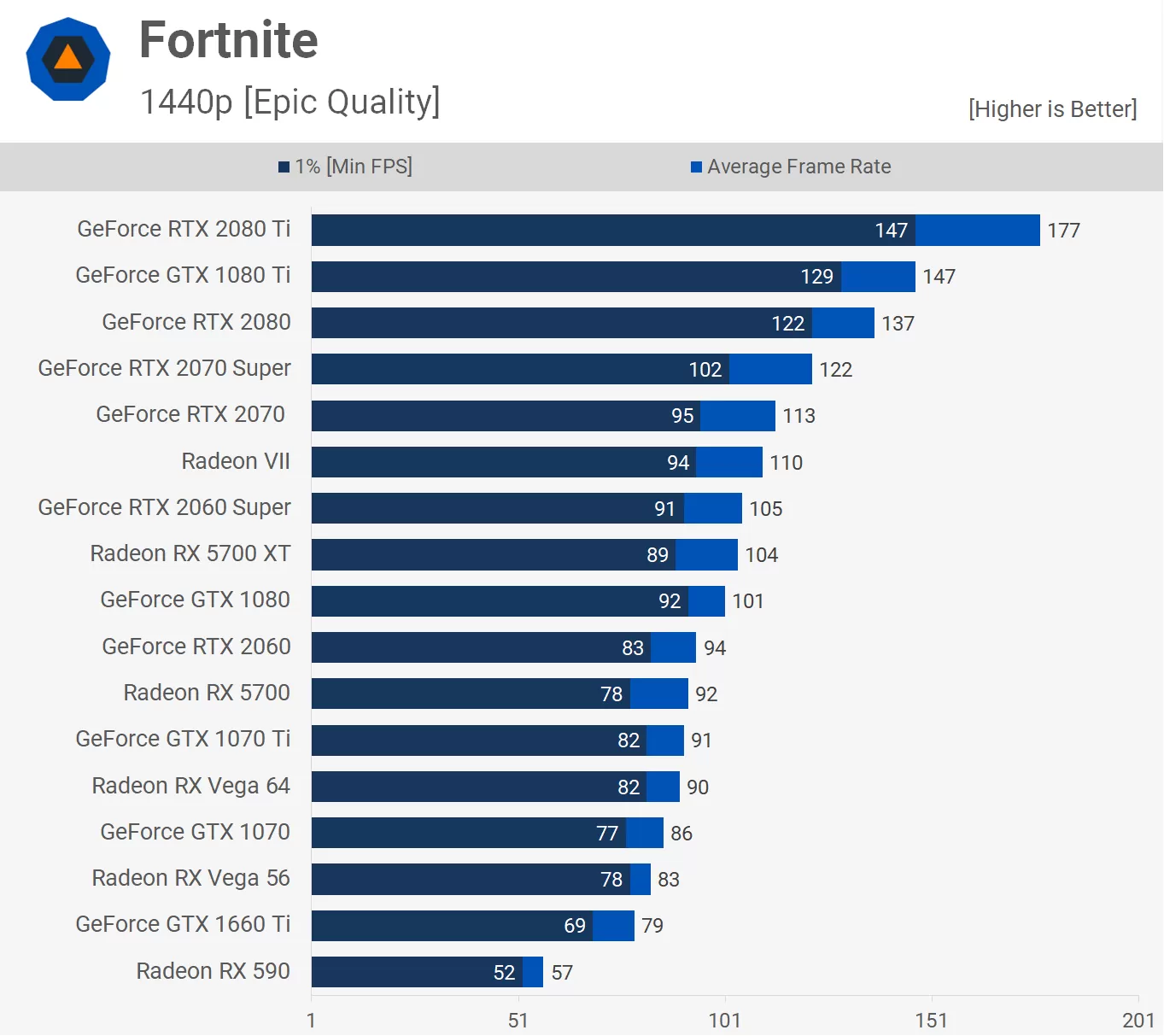
Moving on we find a much stronger result for AMD in The Division 2. Granted they don’t brush aside the GeForce competition, but even so the 5700 matched the 2060 Super while the 5700 XT was just 7% slower than the 2070 Super.
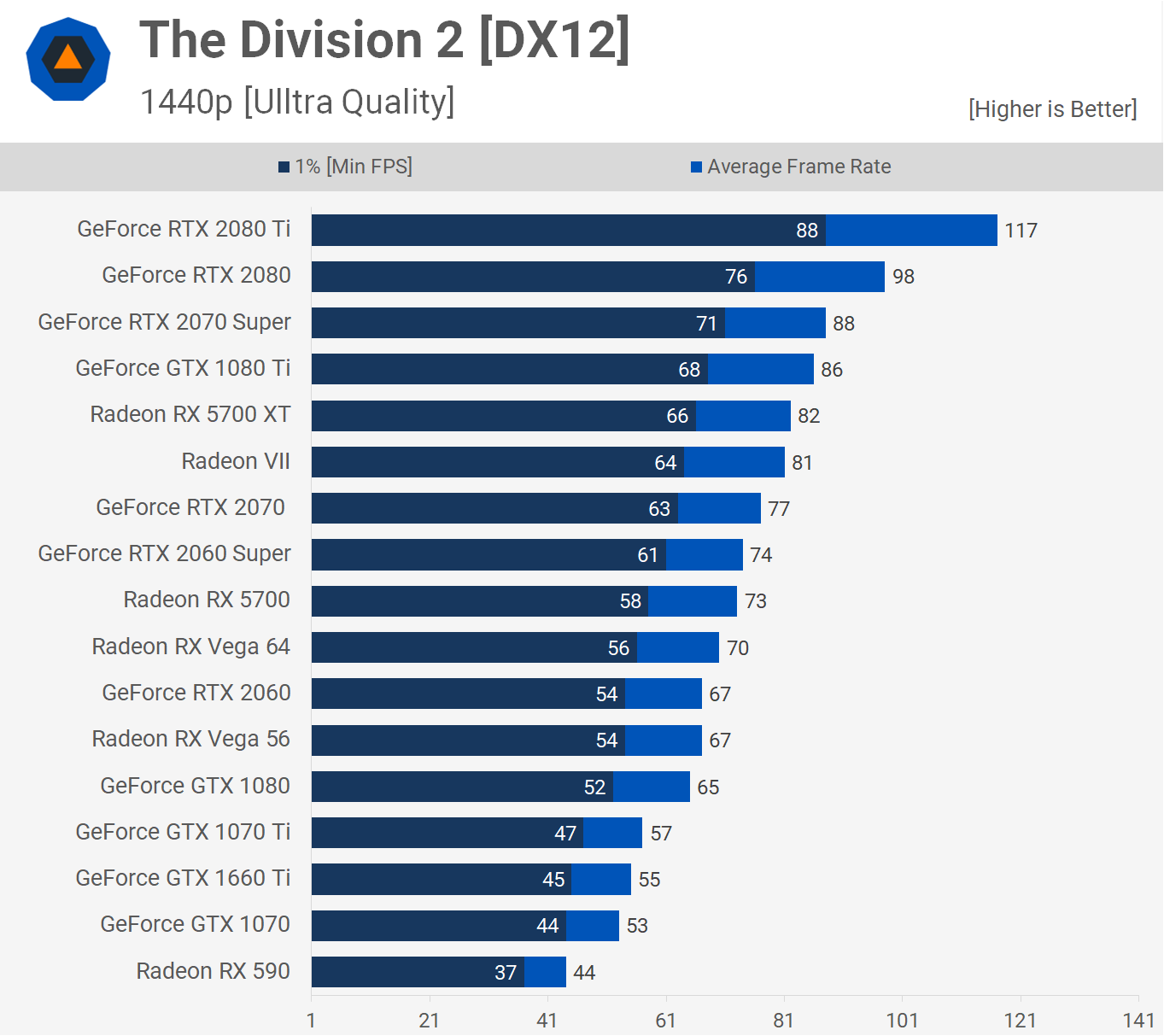
DiRT sees a good result for the new RDNA GPUs. The 5700 matches the 2060 Super and the same is true when comparing the 5700 XT and 2070 Super. This is a highly competitive result for the new AMD GPUs.
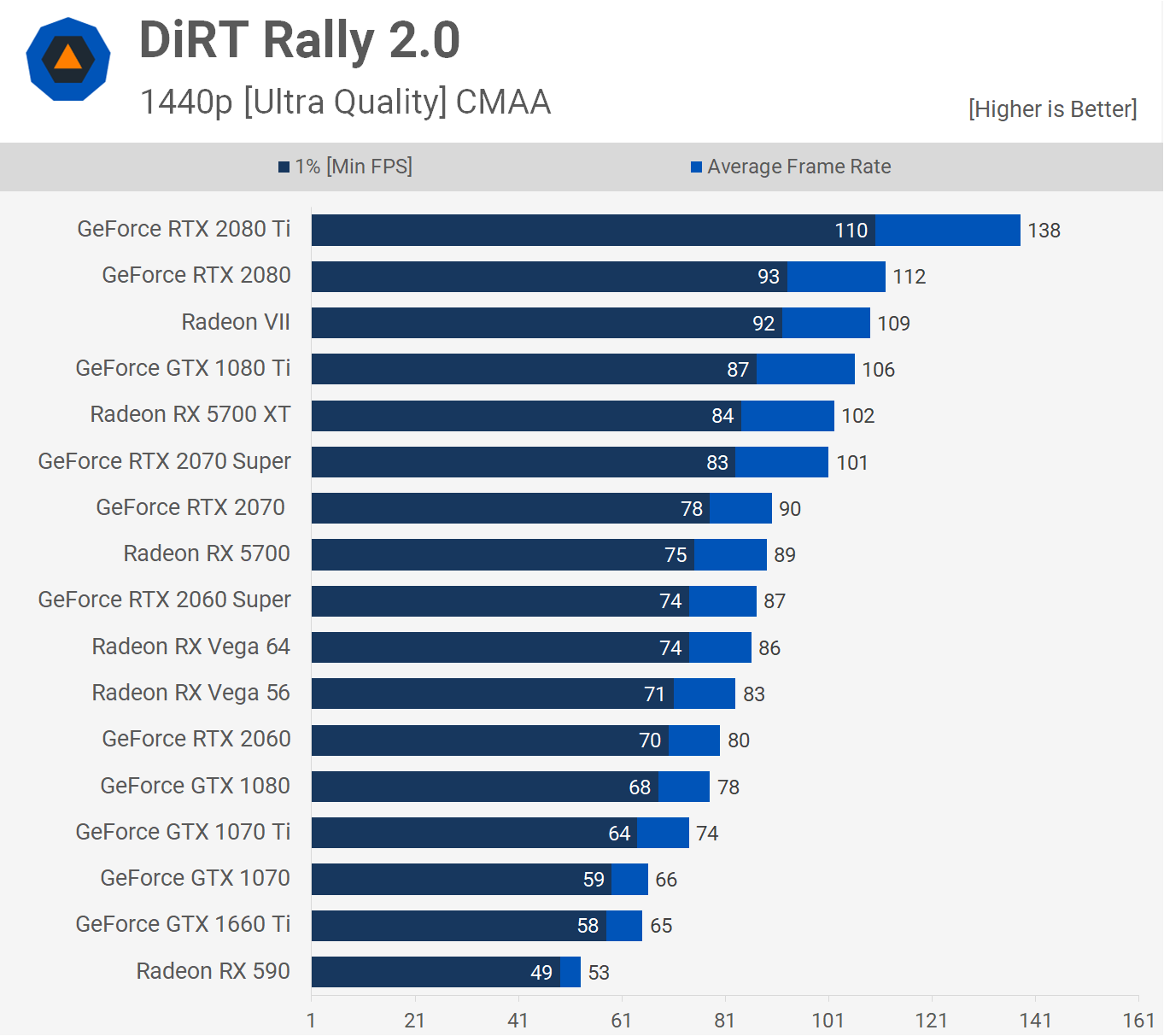
We bet AMD wish every title was as kind to them as Forza Horizon 4 is, what a shellacking. The standard 5700 easily beats the 2070 Super, leaving the 2060 Super behind in a completely different performance tier. Meanwhile the 5700 XT manages to beat even the Radeon VII, spitting out an incredible 131 fps on average, basically placing it on par with the RTX 2080 Ti.
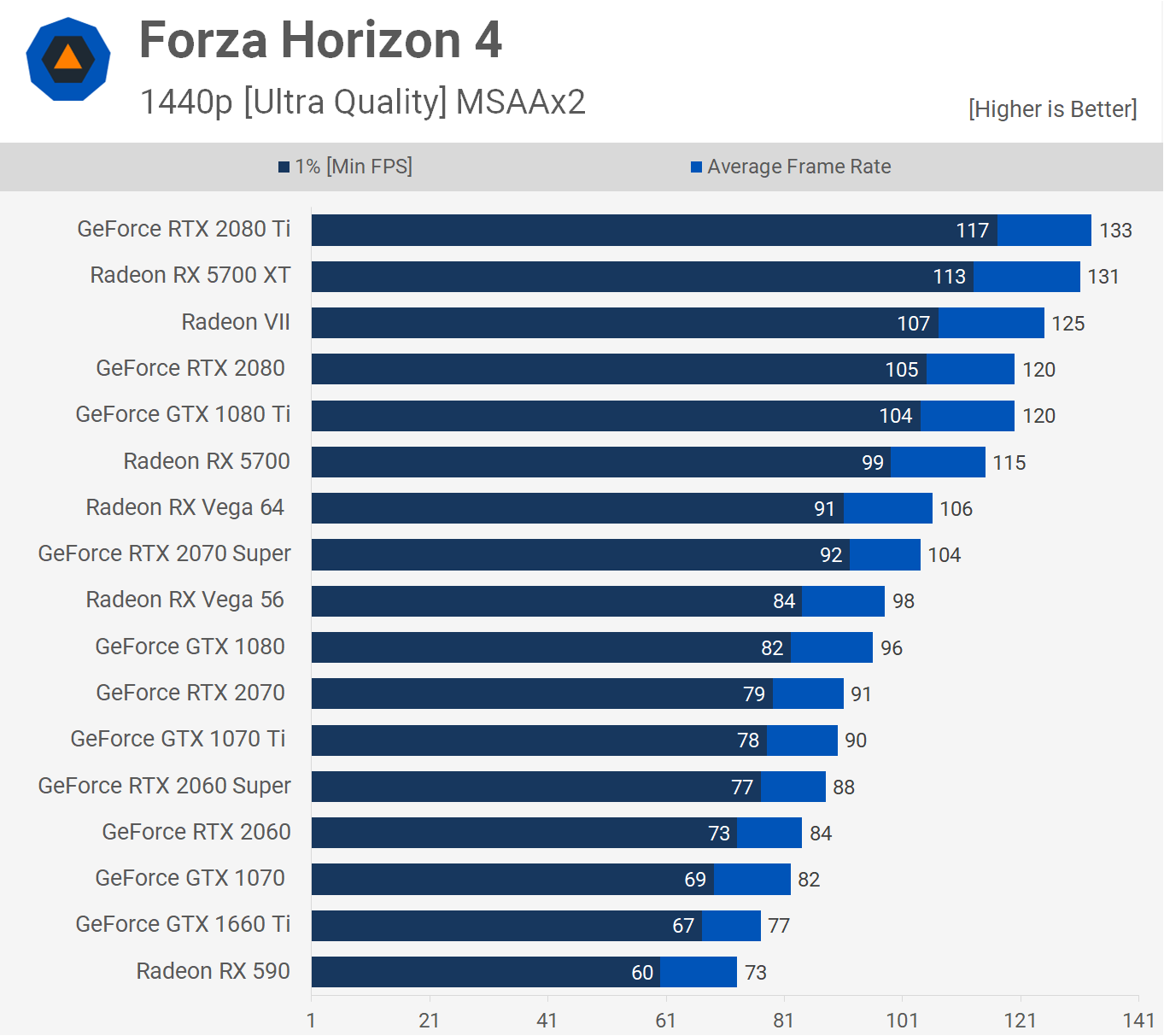
Although not nearly as amazing, the Far Cry New Dawn results are still favorable for AMD as both 5700 GPUs edged out or at the very least matched the GeForce competition. Given they both cost a little less this is a solid result.
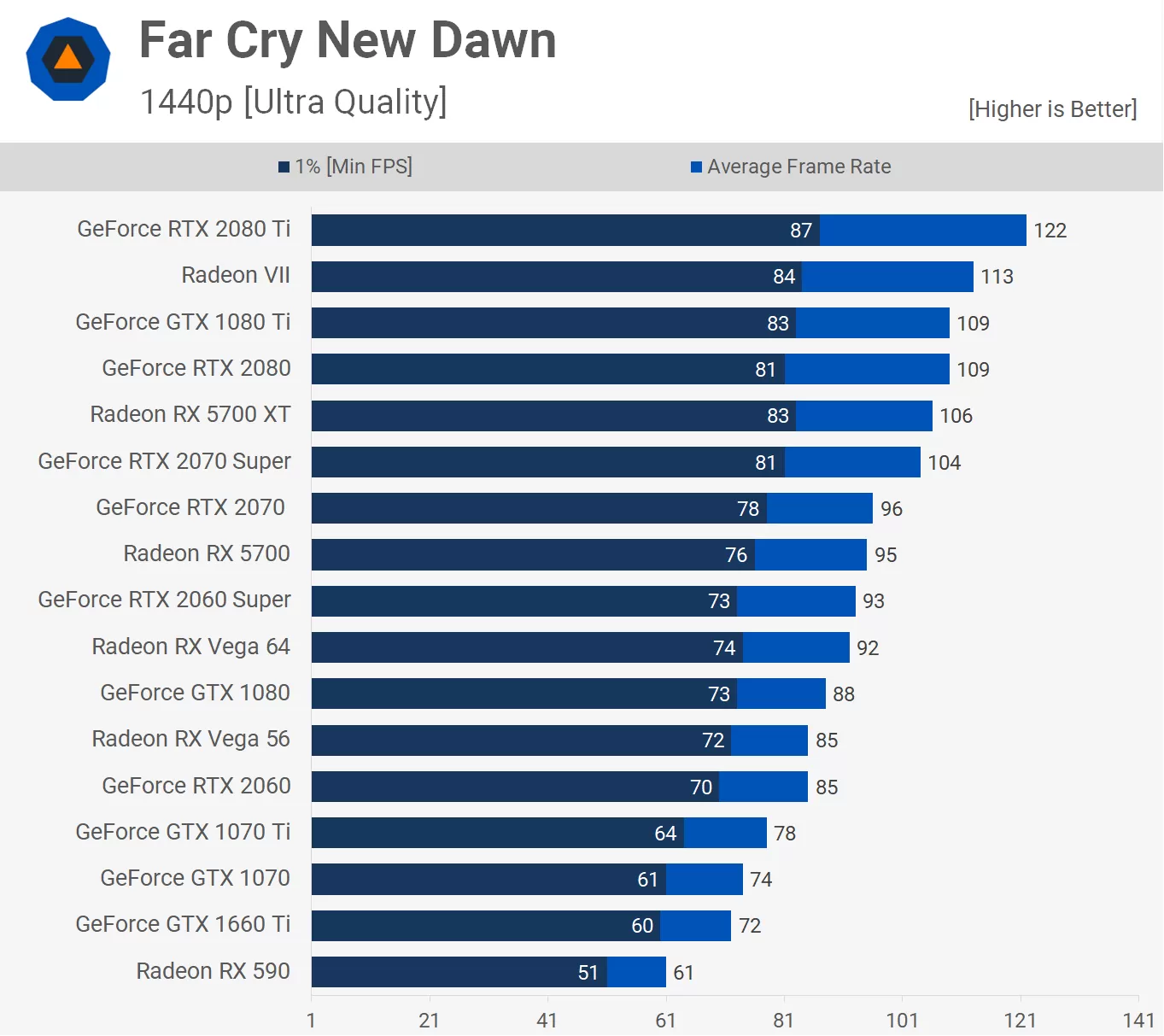
Another stellar result for AMD can be seen in World War Z, where the 5700 and 5700 XT beat their nearest competitor. The 5700 XT even beat the RTX 2080. The standard 5700 was 13% faster than the 2060 Super, though it did only just manage to edge our Vega 56.
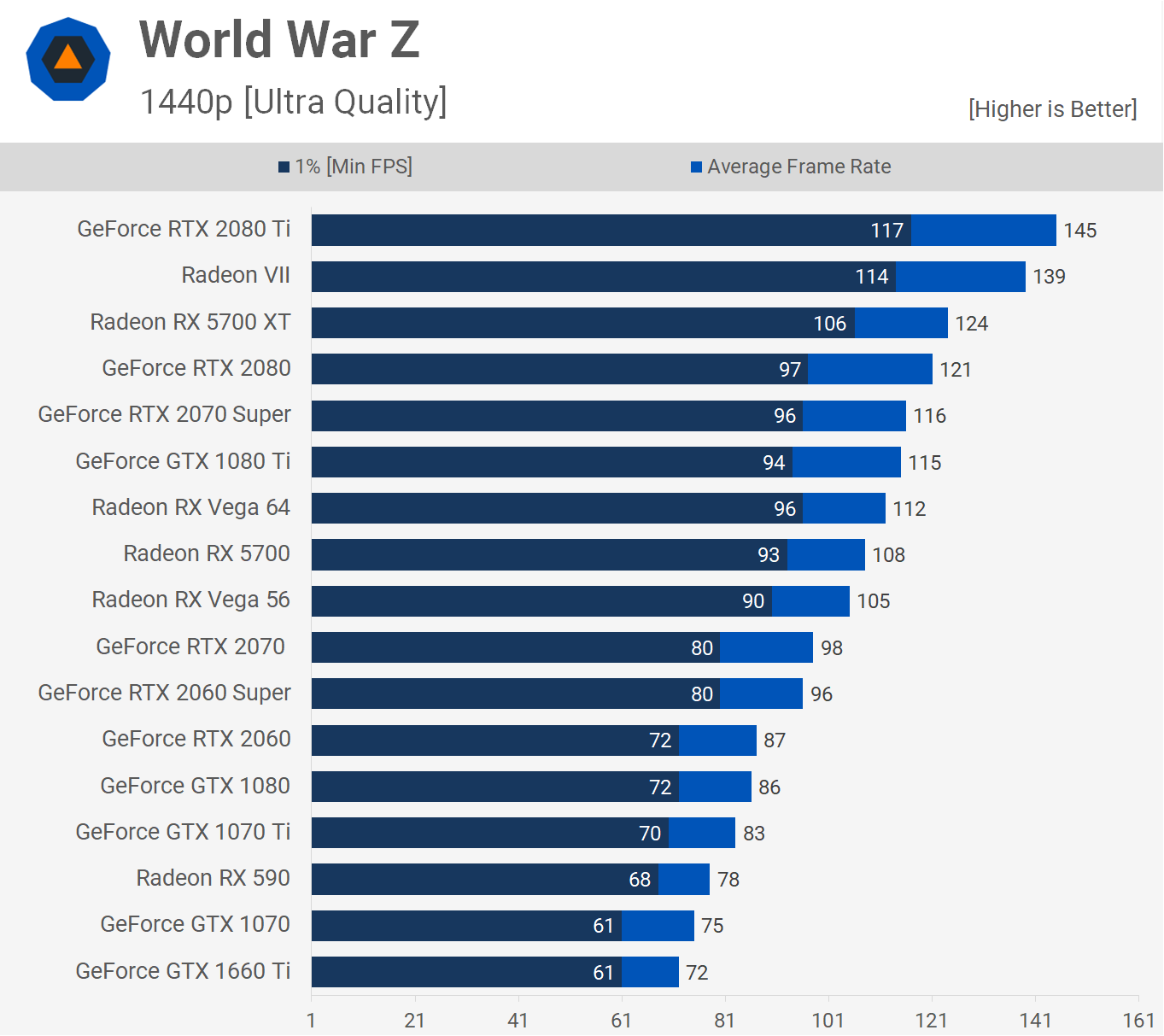
The last game in today's roundup is Assassin's Creed: Odyssey. The 5700 XT was 7% slower than the 2070 Super while the 5700 was 13% slower than the 2060 Super. Not a great result but not too disappointing to end on either.

So with the FPS performance in the bag for a dozen games, let’s move on to check out power consumption.
Power Consumption
Our first graph looks at GPU power exclusively, so not the board power. Interestingly the 5700 XT consumed 6% less power than the RTX 2070 Super and 25% less than the Radeon VII. The standard RX 5700 consumed 27% less power than the XT model and that meant it was much more efficient than even the RTX 2060, so a tremendous result for the base Navi model.
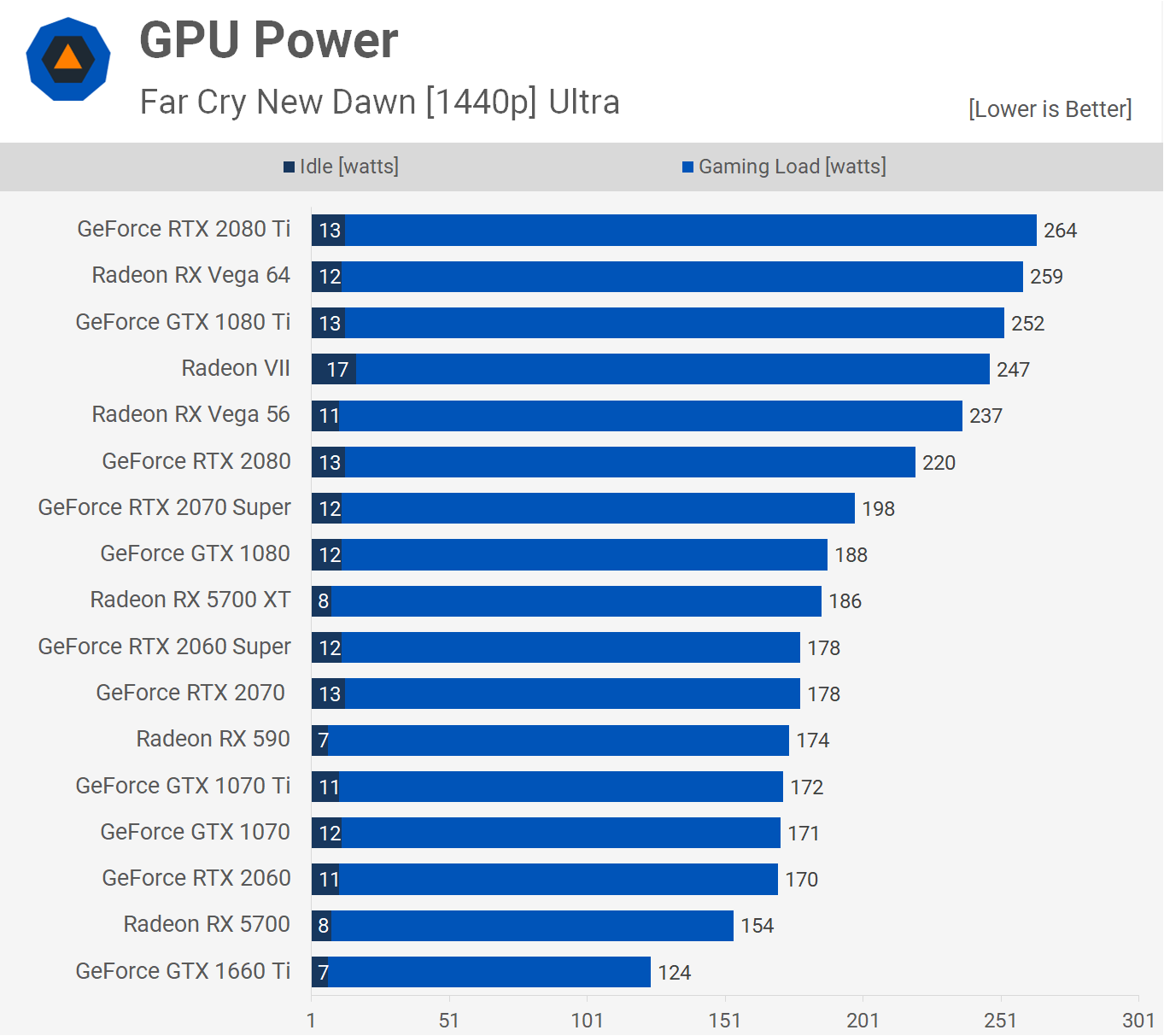
Now when looking at total system consumption, we see a few changes. Now the 5700 XT consumes slightly more power than the 2070 Super which is interesting, it’s not a big change but before it consumed 6% less power in the GPU-only test, now when measuring the entire board plus the system, it consumed 2.5% more power. The 5700 is seen matching the standard 2060 whereas previously it consumed noticeably less power.
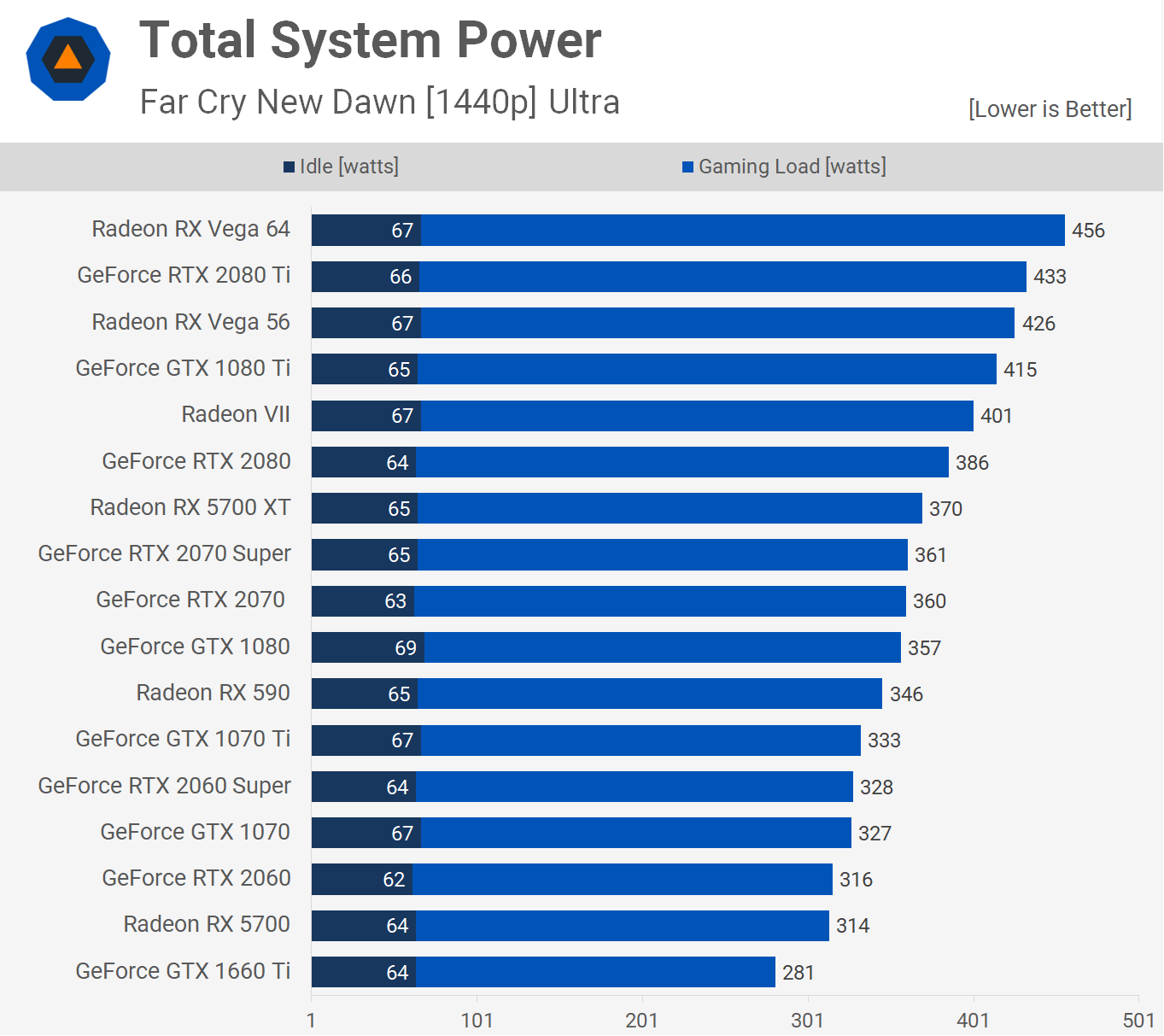
Temperature & Overclocking
Out of the box the Radeon RX 5700 XT runs at 84 degrees and maintains a core clock speed of 1740 MHz and a memory speed of 872 MHz which is basically 14 Gbps. The blower fan typically spun at 2100 RPM in our testing.
Overclocking the 5700 XT saw the core peak at just over 1940 MHz but at times would still drop as low as 1720 MHz and on average we saw a clock speed of 1860 MHz, which is a ~10% overclock. The massive fluctuation was due to the almost 90 degree operating temperature, at 88 degrees the GPU tends to throttle and with the fan running at 43% or 2100 RPM, there was room to move. As for the memory, we were only able to get the GDDR6 up to a transfer speed of 14.3 Gbps, so that was a bit disappointing.
With the core clock jumping all over the place we decided to crank the fan up to 100% -- where it’s incredibly noisy as it spun at 4600 RPM -- in this scenario the GPU peaked at 70 degrees and the 5700 XT was able to maintain a core clock speed of over 2 GHz at all times. That’s about a 20% overclock from stock, I reckon liquid cooling is going to be a popular option for these 5700 XT graphics cards.
As for the standard 5700, out of the box it ran at 75 degrees with a fan speed of 1900 RPM and maintained a typical operating frequency of 1670 MHz. Then when overclocked with the auto fan speed it hit 85 degrees, but the fan was only spinning at 1600 RPM. We can assume this is a bug with the early revision drivers.
For one last test, we cranked the fan speed up to 50% which saw the blower fan spin at 2700 RPM. It got loud but nothing crazy or unbearable. This allowed the 5700 to average a core frequency of 1780 MHz at 70 degrees. Unfortunately, we were unable to push the core any higher as there appears to be a frequency cap at the moment and it’s not clear if AMD will remove it.
Performance Breakdown
Radeon RX 5700 vs. GeForce RTX 2060 Super
First up we have the battle between the RX 5700 and its main competitor, the RTX 2060 Super. From our 12 game sample the Radeon was on average 1% faster, but this is not realistic as the massive win in Forza Horizon 4 skewed the result. If we remove the Forza outlier, the RX 5700 is just 2% slower on average. With that we can say it's close enough to call a tie and we generally do this when discussing margins below a 5% difference.
We observed competitive performance in DiRT Rally 2, Far Cry New Dawn, The Division 2, Shadow of the Tomb Raider and Resident Evil 2. So it will be interesting to see how these two stack up when it comes to the cost per frame comparison.
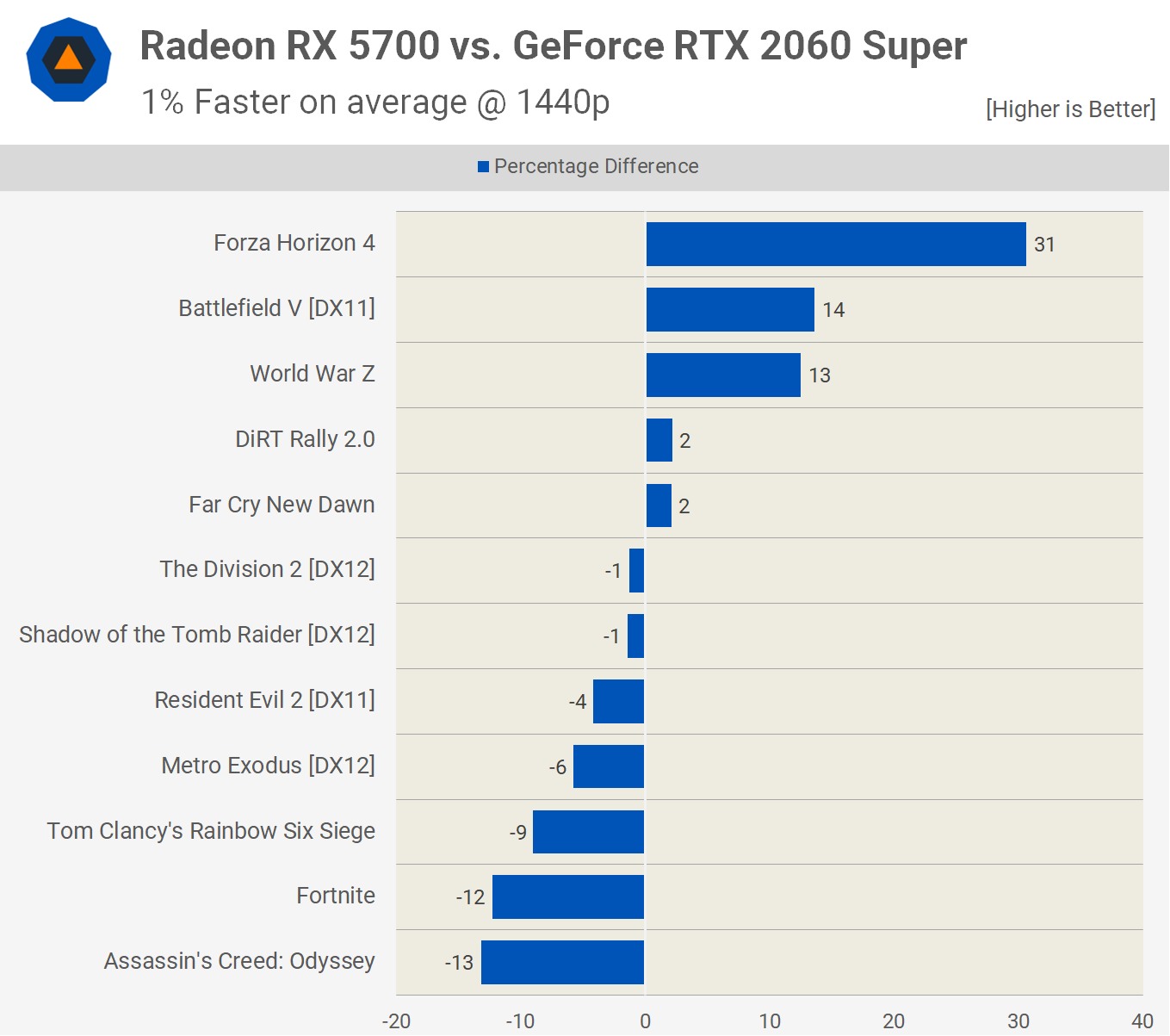
Radeon RX 5700 vs. GeForce RTX 2070
When compared to the original RTX 2070 which will soon leave the market, the RX 5700 was 2% slower on average. Again it enjoyed that big Forza Horizon 4 result, but even so it pulled off solid wins in World War Z and Battlefield V.
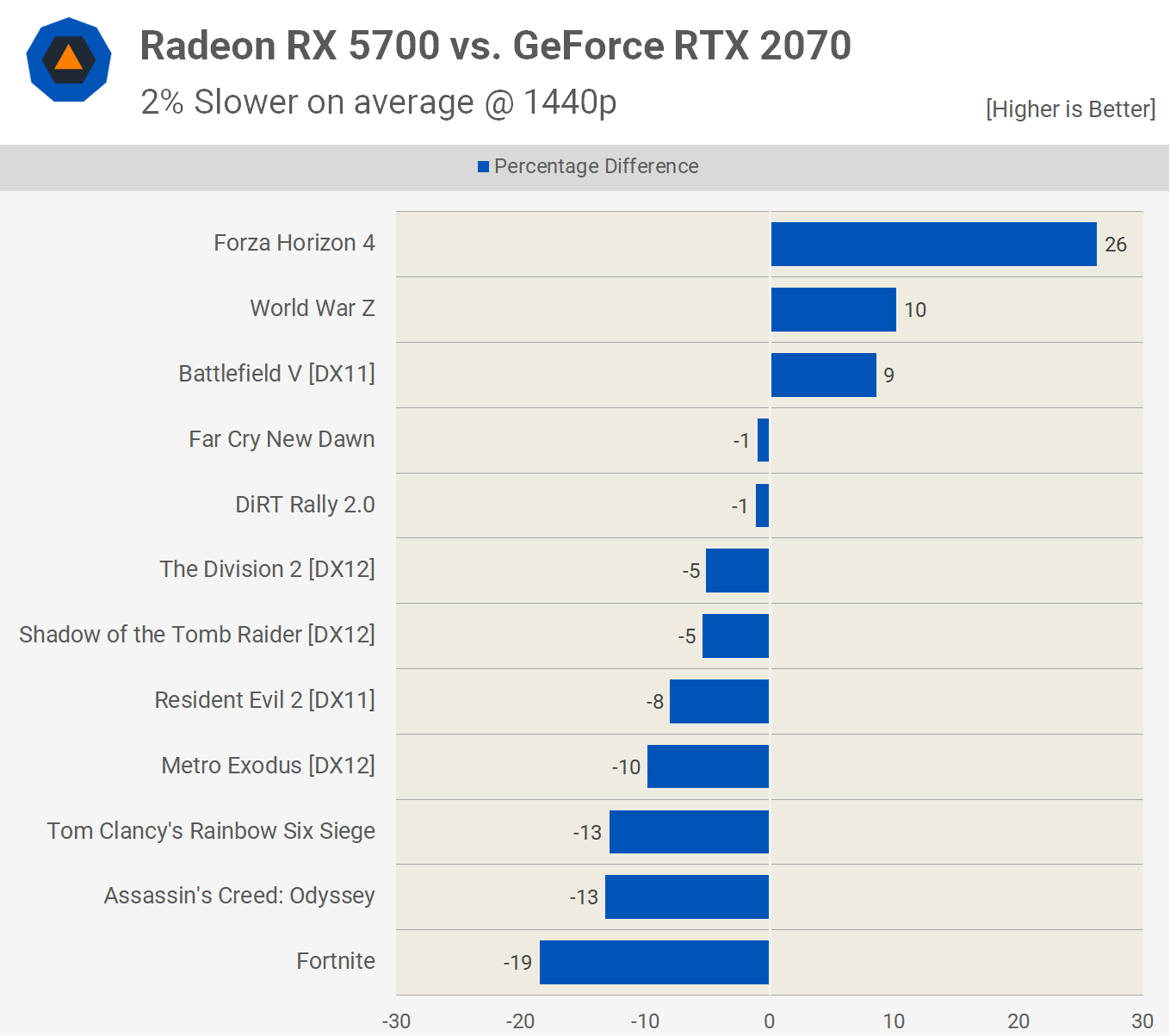
Radeon RX 5700 vs. Radeon Vega 56
Against Vega 56, the new RX 5700 was 11% faster on average. Not a massive performance uplift after 2 years, but the 5700 is a significantly less complex GPU so AMD will be able to turn a profit selling it, even at $350, so there’s that.

Radeon RX 5700 XT vs. GeForce RTX 2070 Super
Next up we have the 5700 XT and it also does well in its battle with the RTX 2070 Super. It was just 4% slower than the GeForce when we removed the Forza Horizon 4 result.
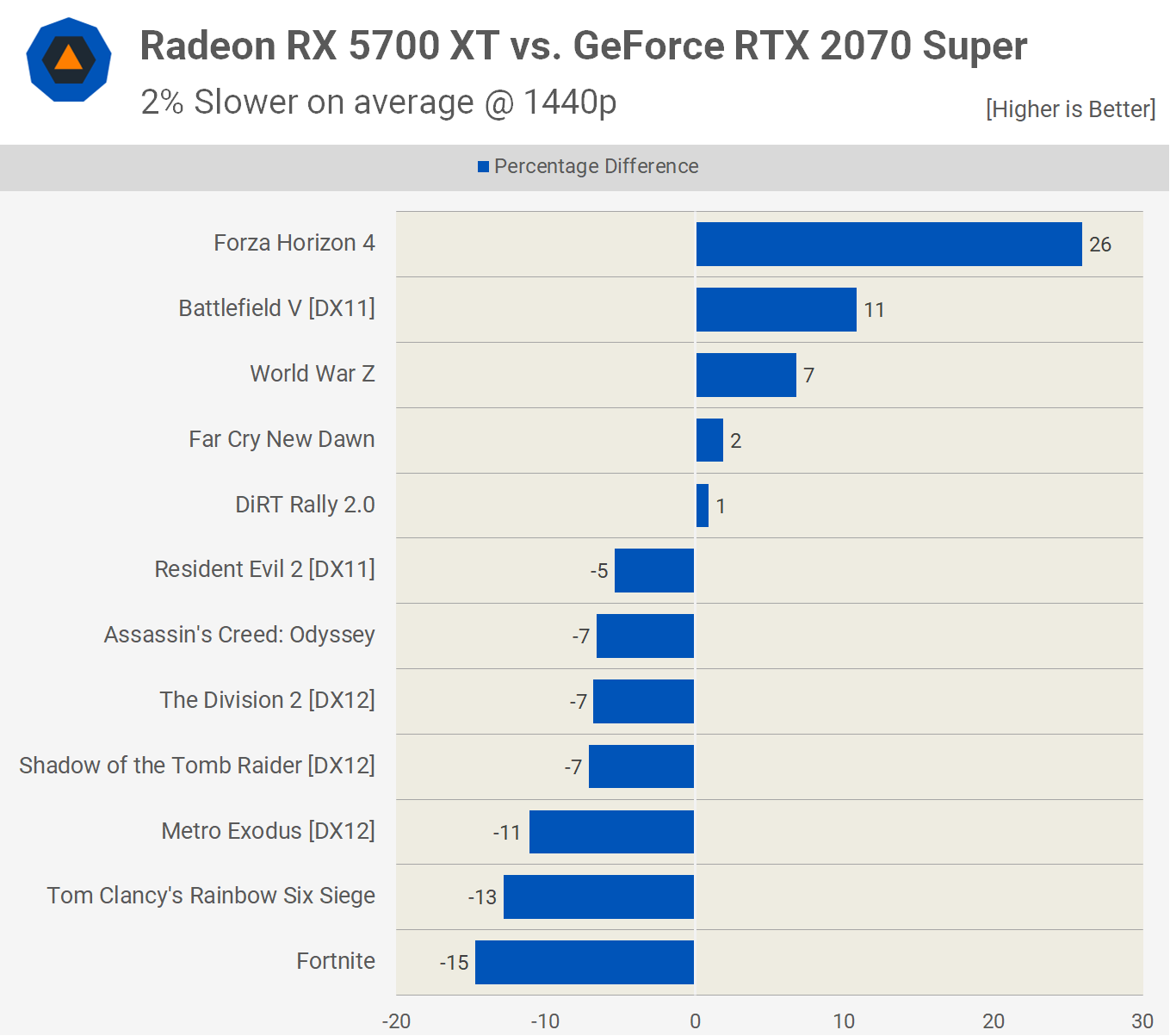
Radeon RX 5700 XT vs. GeForce RTX 2080
The 5700 XT was also 9% slower than the much more expensive RTX 2080, so you can see why Nvidia feels the need to introduce an RTX 2080 Super. At times the Radeon GPU was up to 20 - 24% slower, but that still makes the 5700 XT a better value option.
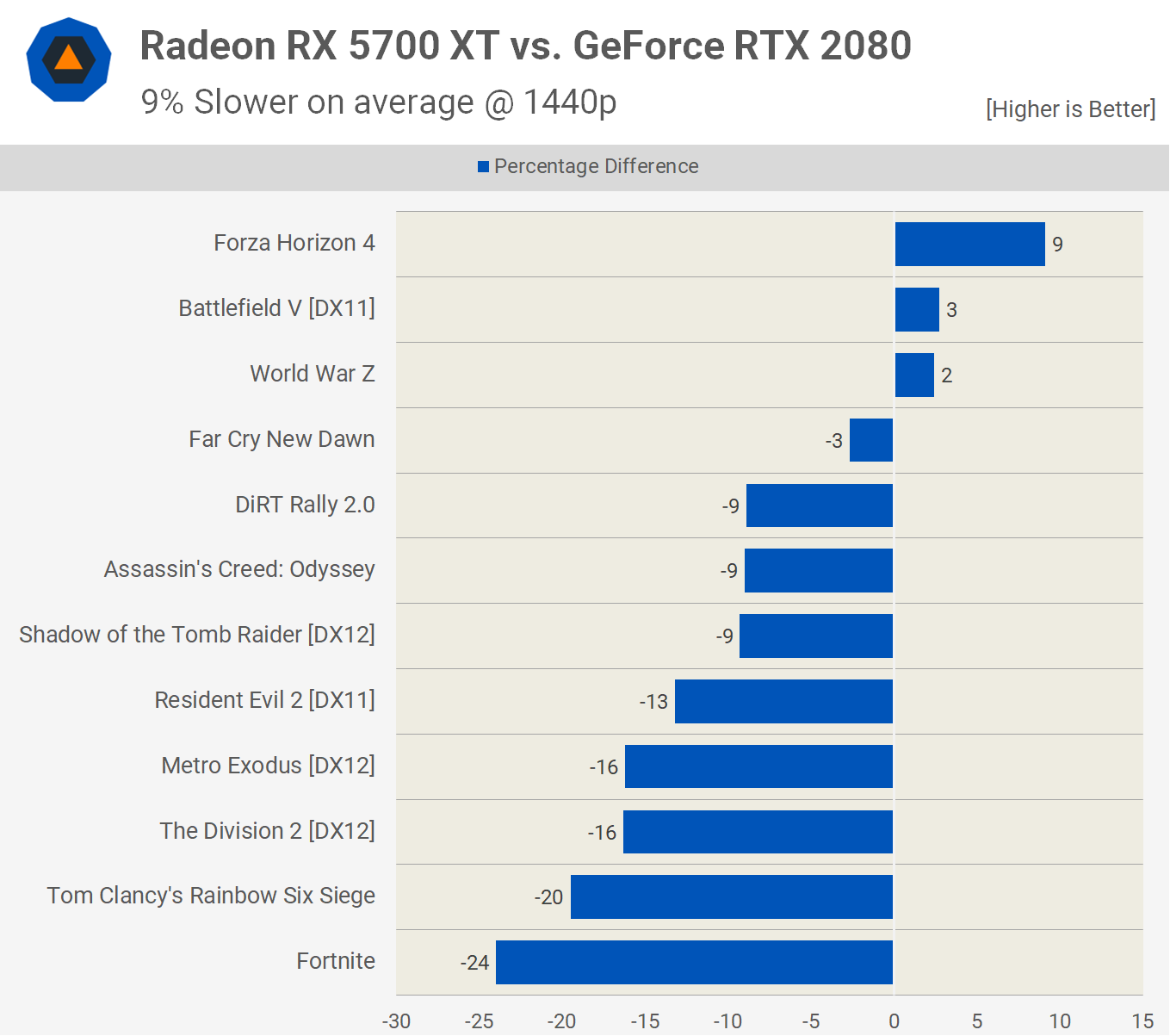
Radeon RX 5700 XT vs. Radeon VII
Speaking of value, the 5700 XT, like the 2070 Super, not only eliminates the standard 2080 but it also waves goodbye to the compute-heavy Radeon VII. The newer Navi-based card is 6% slower, so we hope you didn’t recently drop around $700 on a Radeon VII.
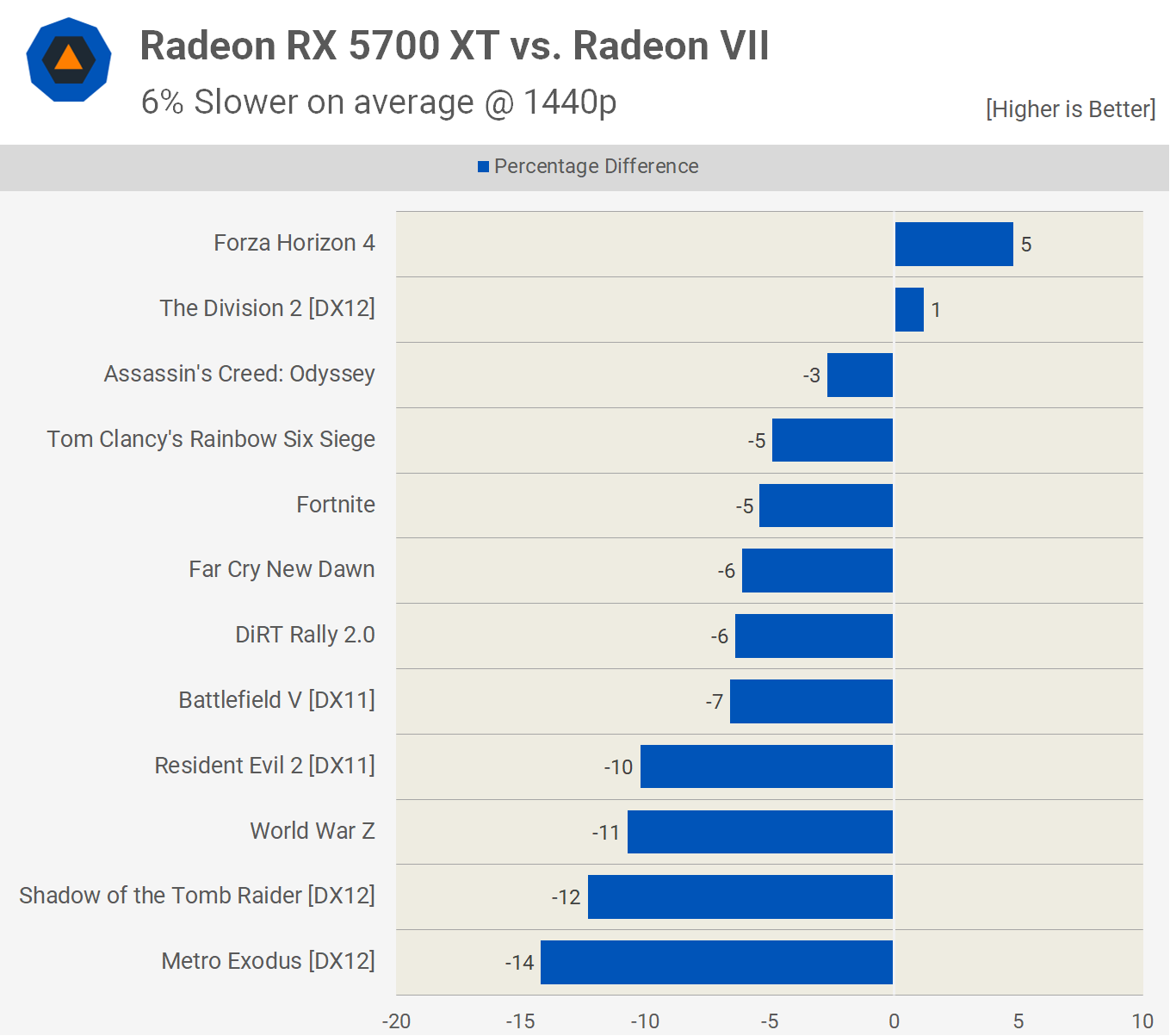
Cost per Frame Comparison
First we have an MSRP comparison using launch prices. Compared to Vega 56’s $400 MSRP, the 5700 XT offers a massive 21% discount per frame, while the standard RX 5700 provides a 22% discount, so that’s nice.
It’s also a massive improvement over the Radeon VII and we only got that 5 months ago. At a cost of $6.54 per frame the 5700 XT saves you almost 40% as you're basically getting the same performance for $300 off, but we won’t pretend like the Radeon VII or RTX 2080 were ever particularly good value, so let’s move on to a comparison with the current market prices.
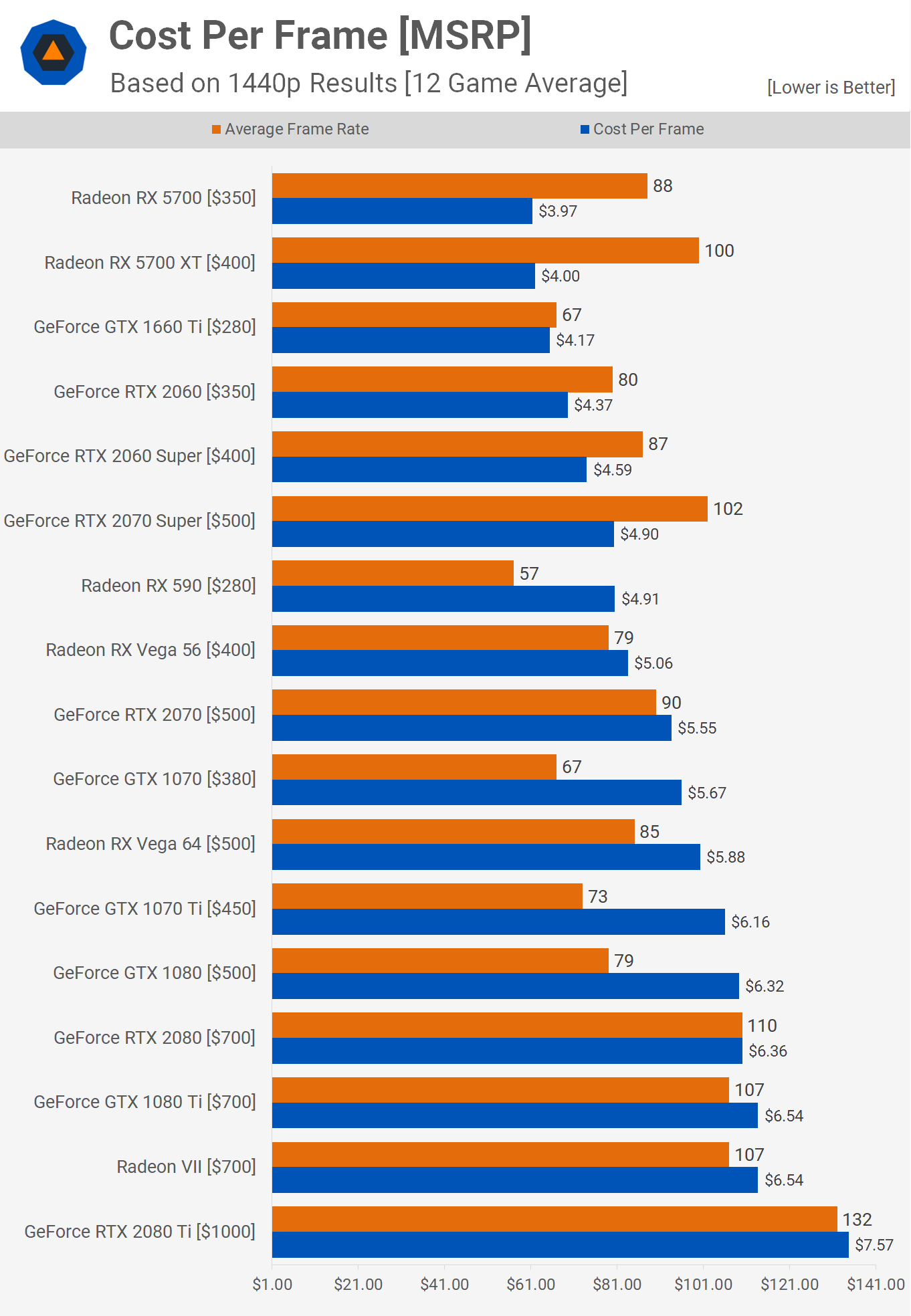
Even here the RX 5700 and 5700 XT look nice at their adjusted MSRPs. Maybe AMD could have done with the original prices announced a few weeks ago, but evidently they wanted to go for a good value and try to disrupt the otherwise GeForce-dominated market. The new Navi GPUs are more cost effective than the 2060 Super, standard 2060 and GTX 1660 Ti.
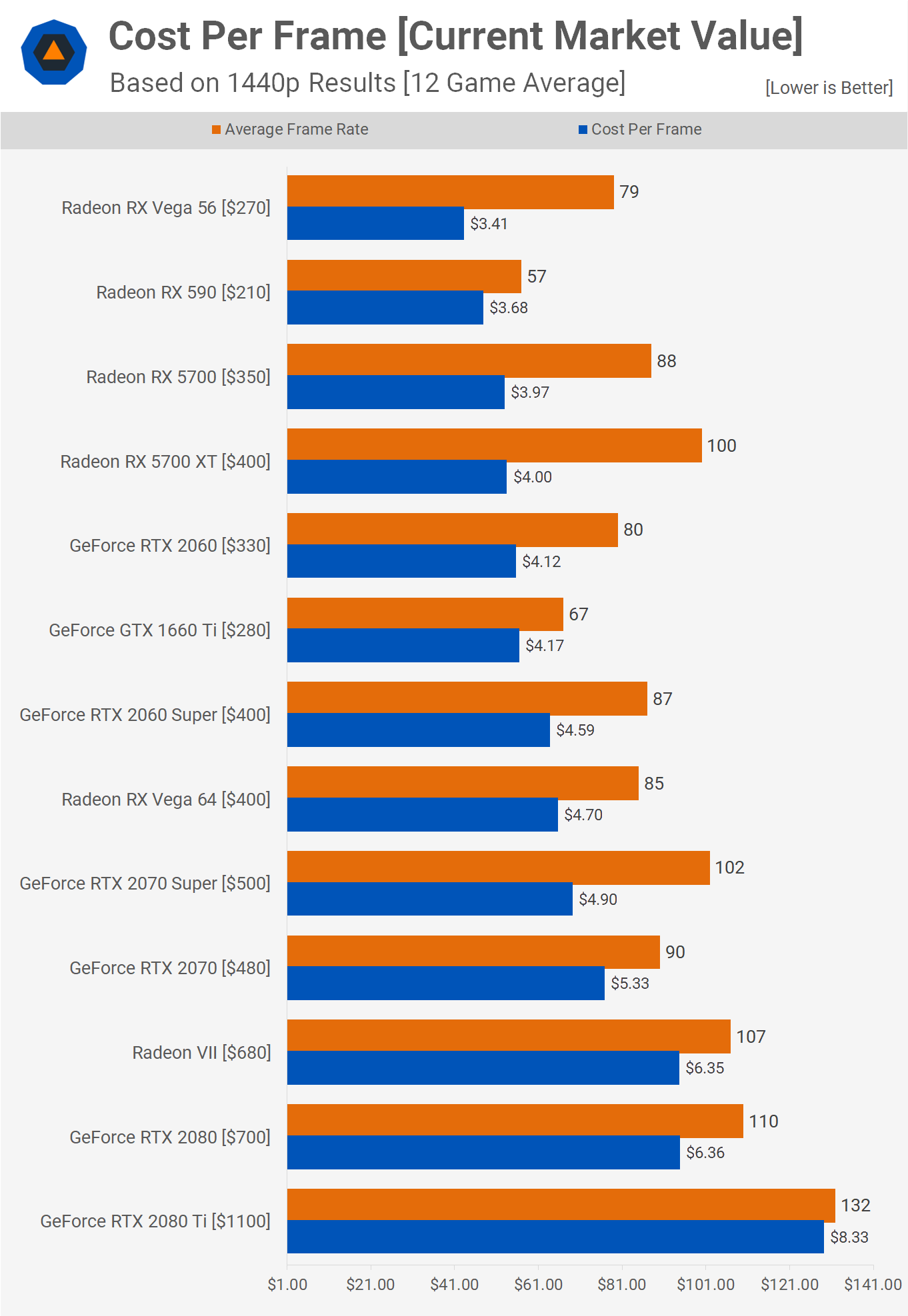
The RX 5700 comes in at a rather large 14% discount per frame when compared to the RTX 2060 Super, and the RX 5700 XT is 18% under per frame compared to the 2070 Super. So that's actually really good.
Closing Thoughts
When we tested the new GeForce Super graphics cards last week, we pointed out the obvious. That was Nvidia's attempt to steal AMD’s thunder as Navi was about to launch the week after. The RTX 2070 Super is a solid addition no matter what camp you are on, killing off the Radeon VII, RTX 2070 and even the RTX 2080. The 2060 Super wasn't as exciting as it essentially slotted into the existing pricing structure.
Forcing AMD’s hand to an extent, the company moved to cut pricing which has sparked further interest on what these Navi GPUs can deliver. In terms of performance the RX 5700 can essentially match the RTX 2060 Super, which until a week ago was RTX 2070-like performance -- making it slightly faster than Vega 64. For $350, that's exceptionally good value.
Then we have the RX 5700 XT which finds itself in a sweet spot at $400, coming out at a cost of just $4.00 per frame in our testing, it's a better value than cheaper products such as the original RTX 2060 and the GTX 1660 Ti. Not to mention you’re getting near 2070 Super performance at a rather hefty discount.
Availability will be key, if AMD is able to stock shelves with $400 5700 XT’s and $350 5700’s, then they will offer the best value at these price points. We're being told custom AIB models are on the way, too, and if they can boost out of the box performance a little, while bringing about the typical AIB card advantages, then Nvidia might be forced into making a few adjustments of their own and at that point we’ll have a good old fashioned GPU pricing war on our hands.
The reference model cards we tested were relatively quiet and nothing like the Radeon VII. The fans on the 5700 XT only spun up to 2100 RPM after an hour-long stress test and while the GPU was sitting at a little over 80 degrees, that’s ok considering the blower style cooler that is not exactly ideal. The setup is usable and you certainly won’t require the use of earmuffs, again, we're looking at you Radeon VII.
Bottom line, we like what we see from AMD as they're finally competitive at the mainstream graphics level, not just in terms of price and sheer performance, but efficiency as well. At the same time, the new Radeons are catching up to Nvidia's offerings that have been out for about a year -- sans-ray tracing which is not very usable in this generation -- but at better overall value and price points. We hope a few weeks from now stock levels are good and pricing is at or very close to the MSRP.
Watch out for upcoming articles as we look at Radeon Image Sharpening (think DLSS from AMD) and further analysis on both CPU and GPU sides.
Shopping Shortcuts:
https://www.techspot.com/review/1870-amd-radeon-rx-5700/Bagikan Berita Ini
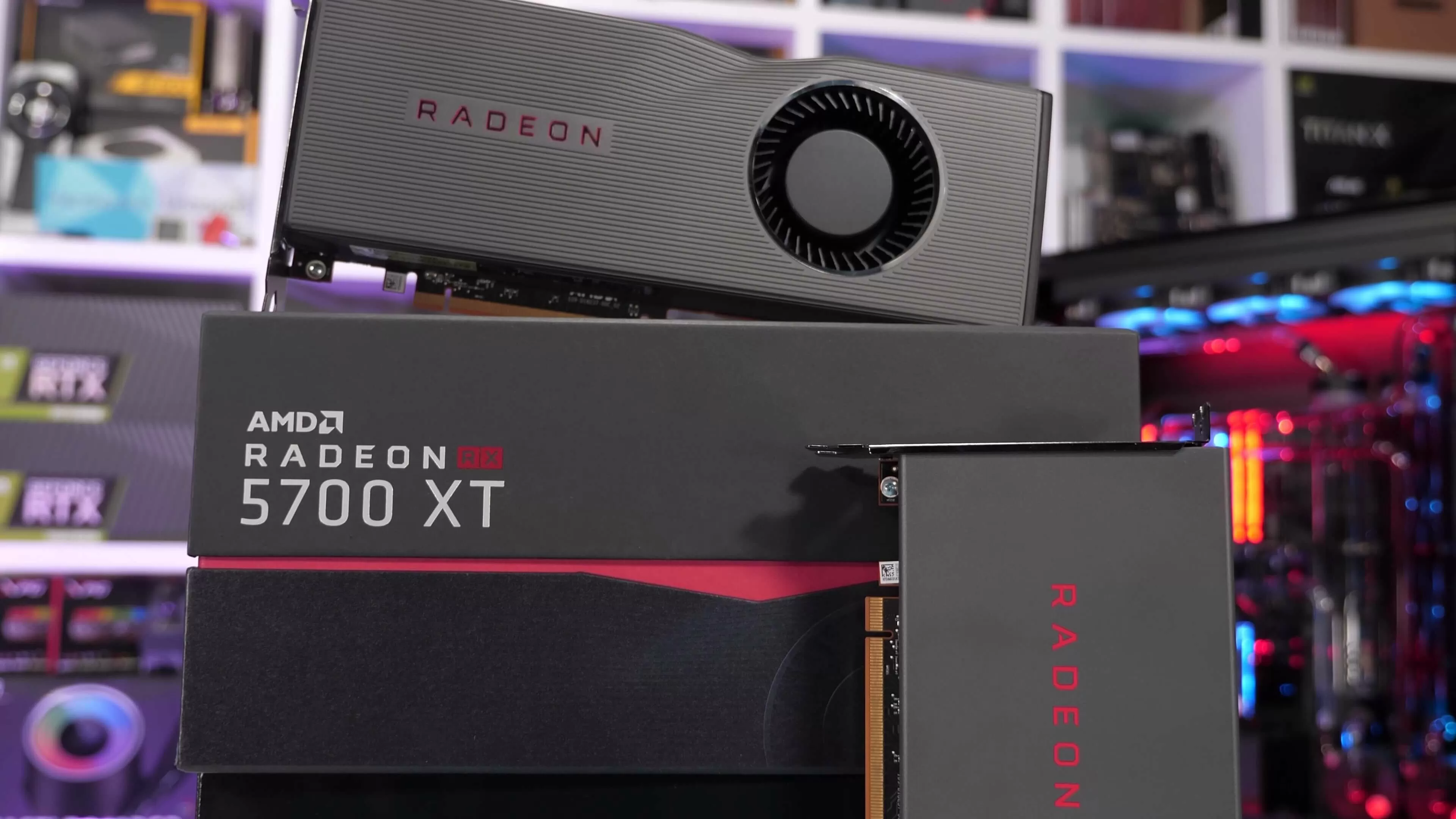
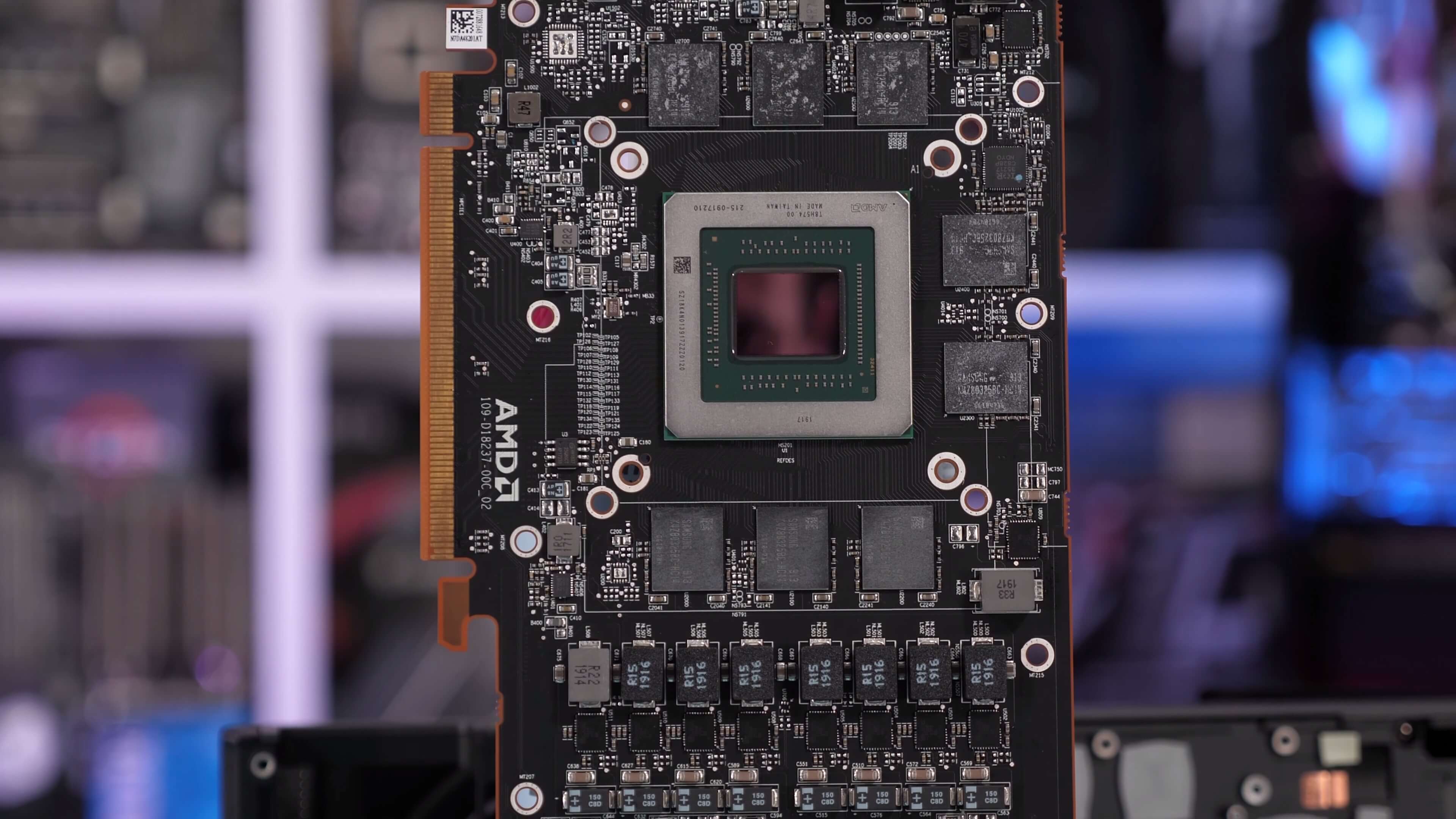
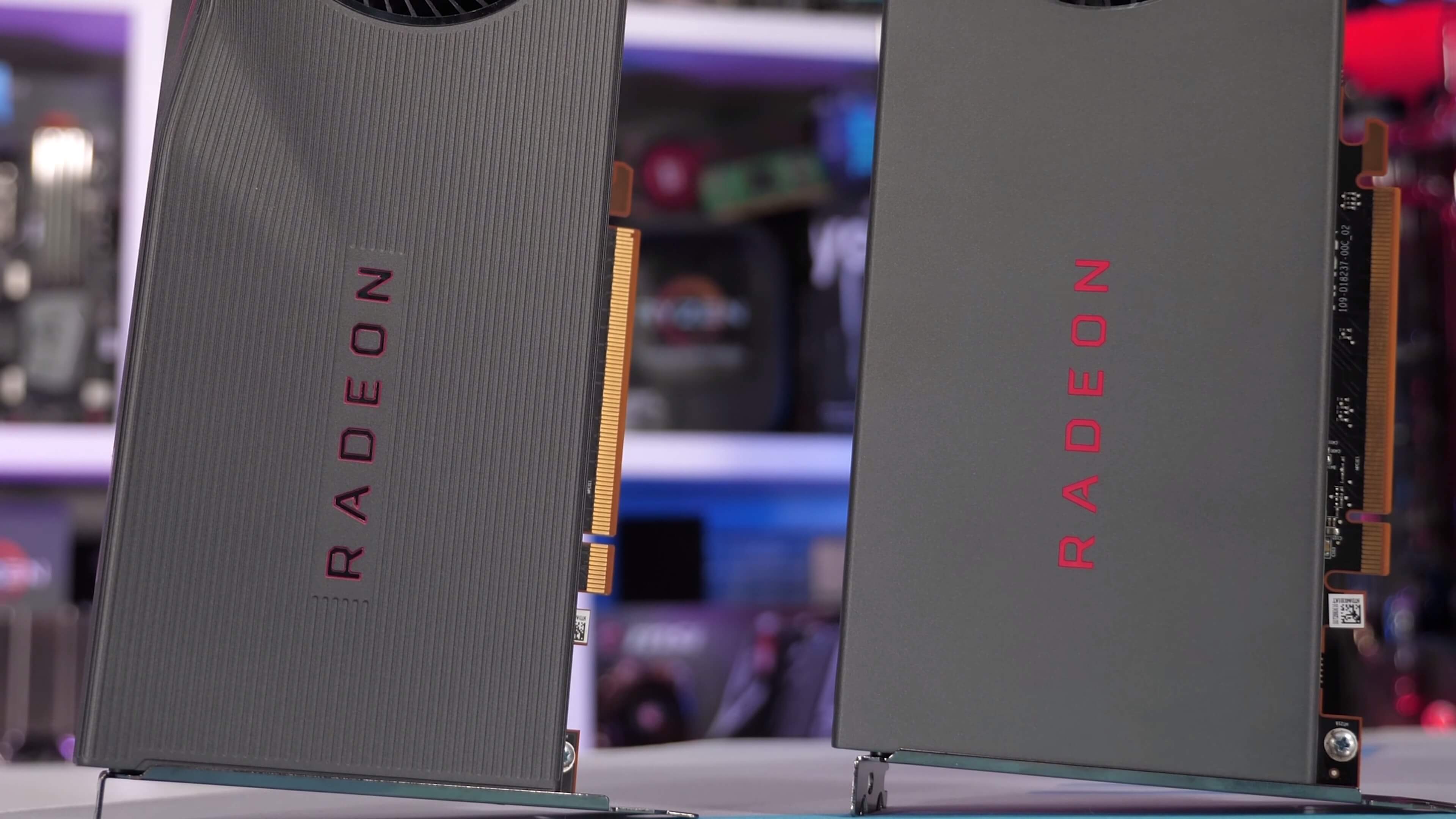
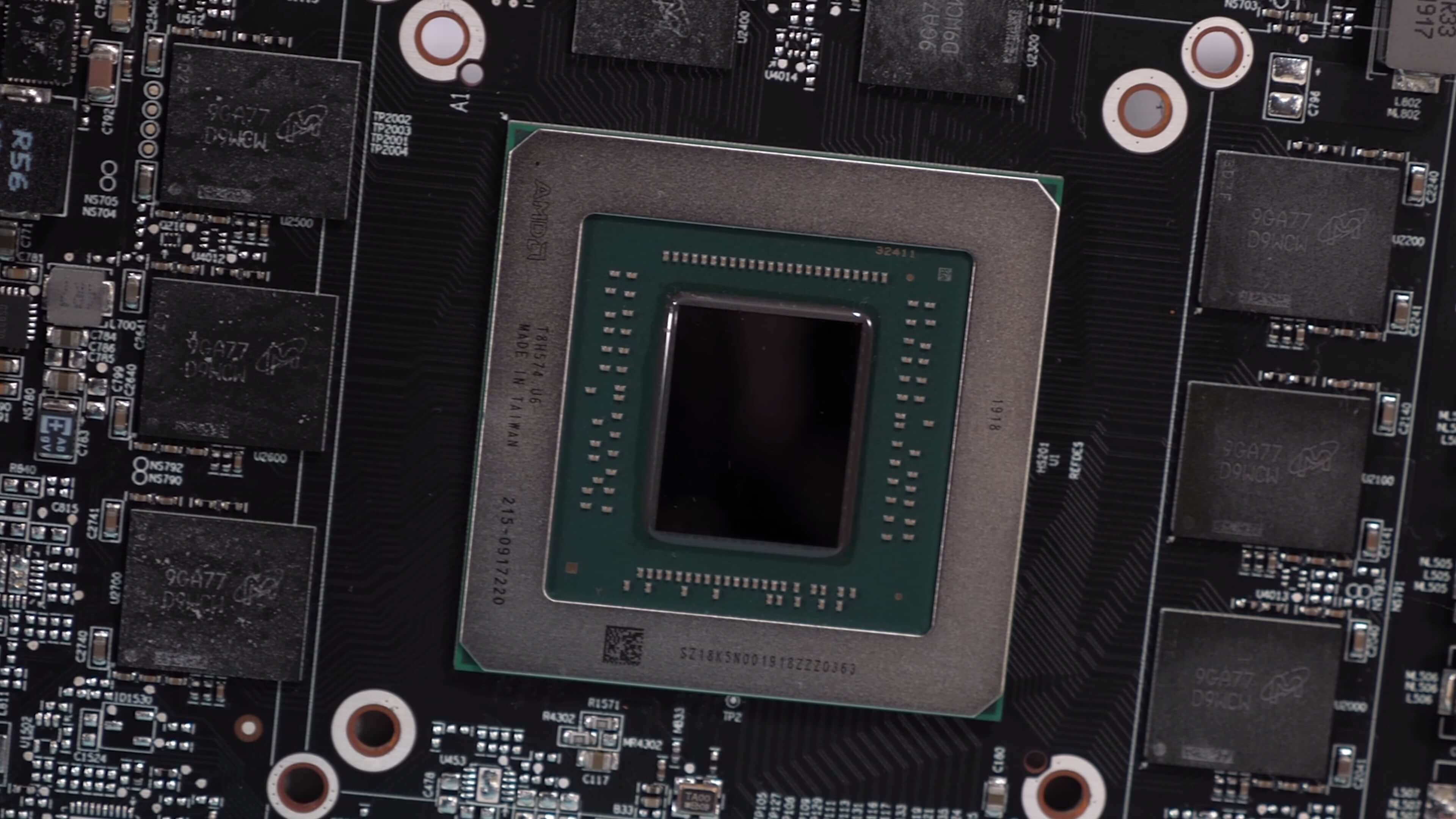
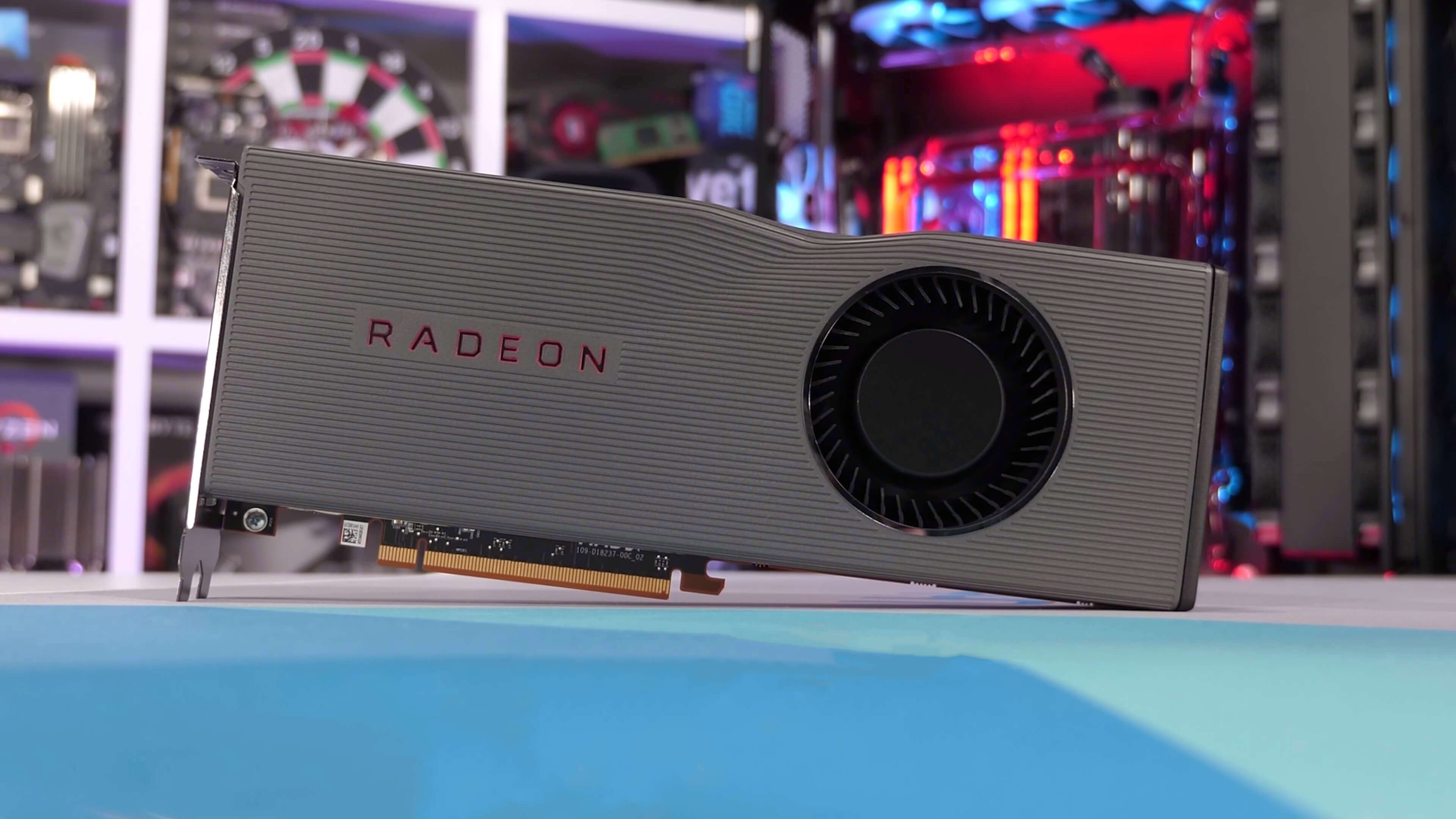
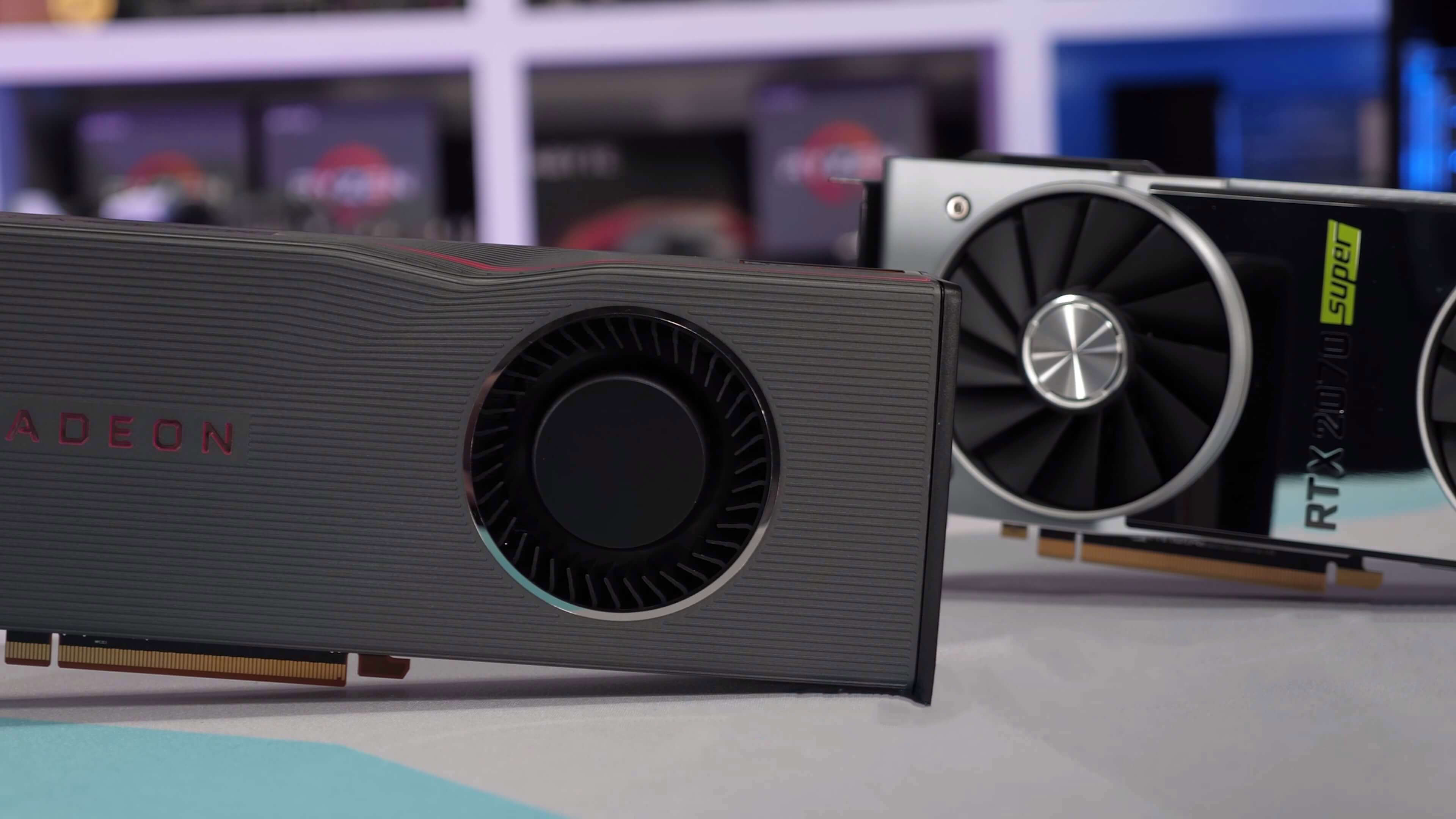
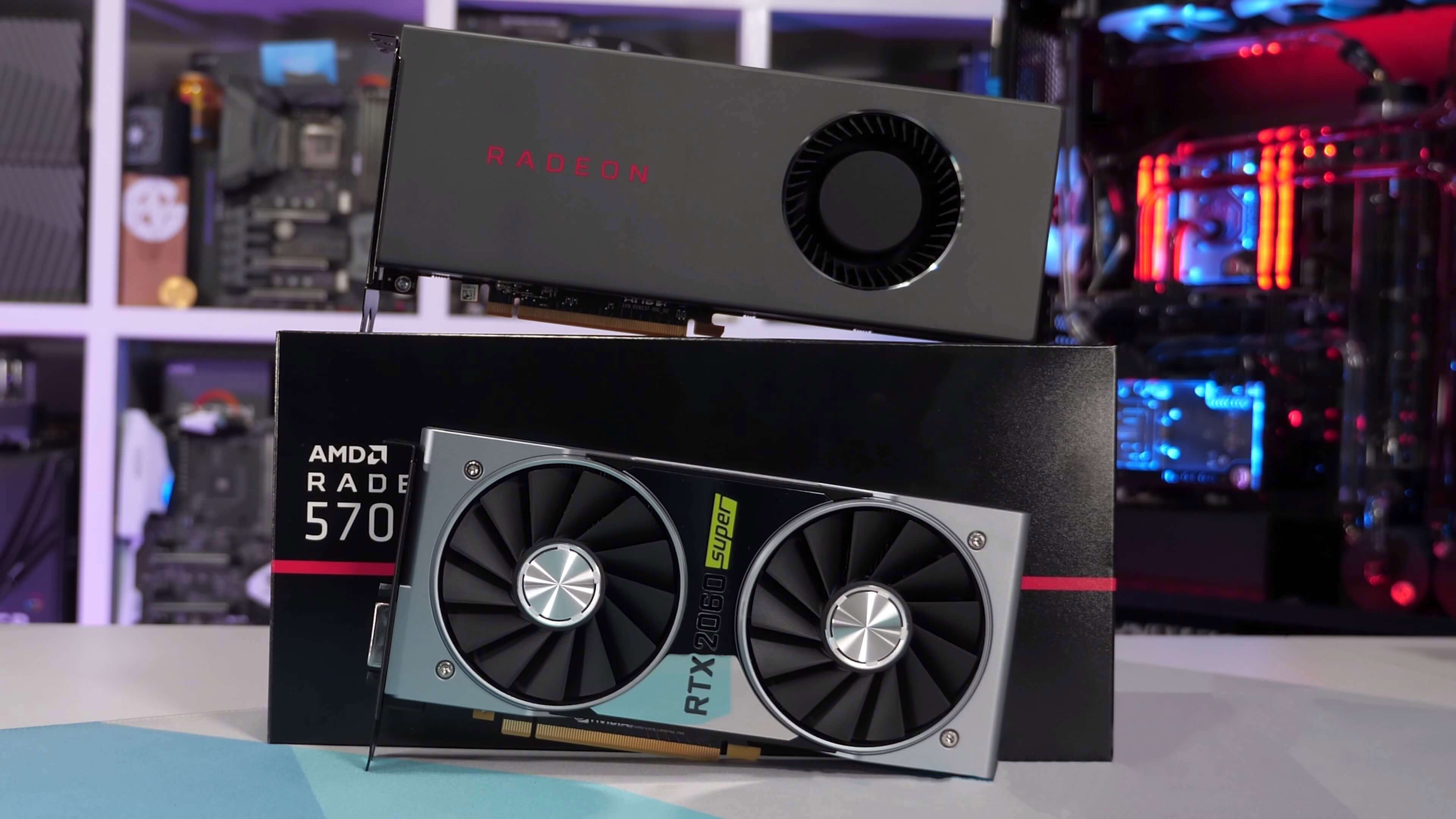
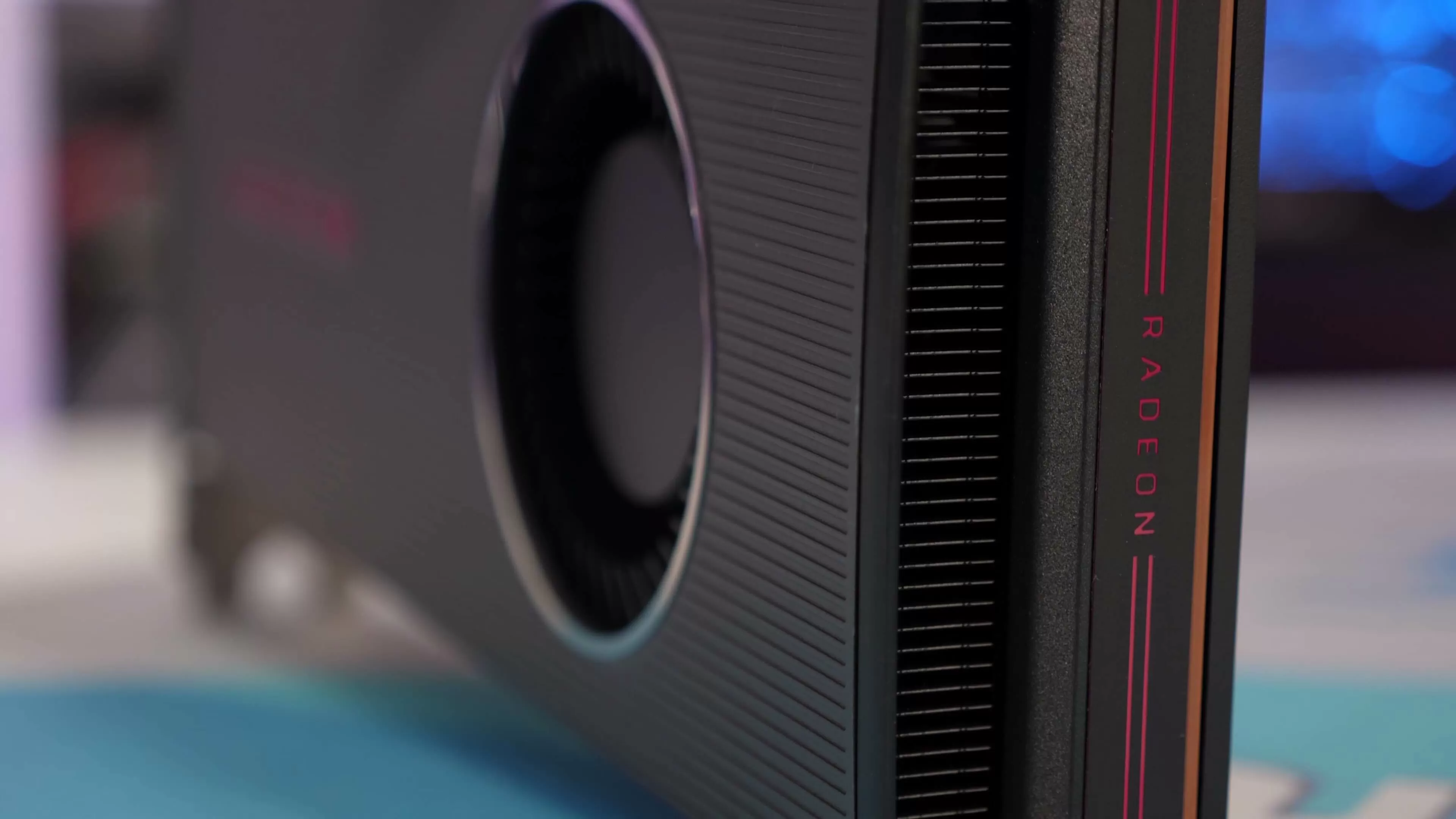
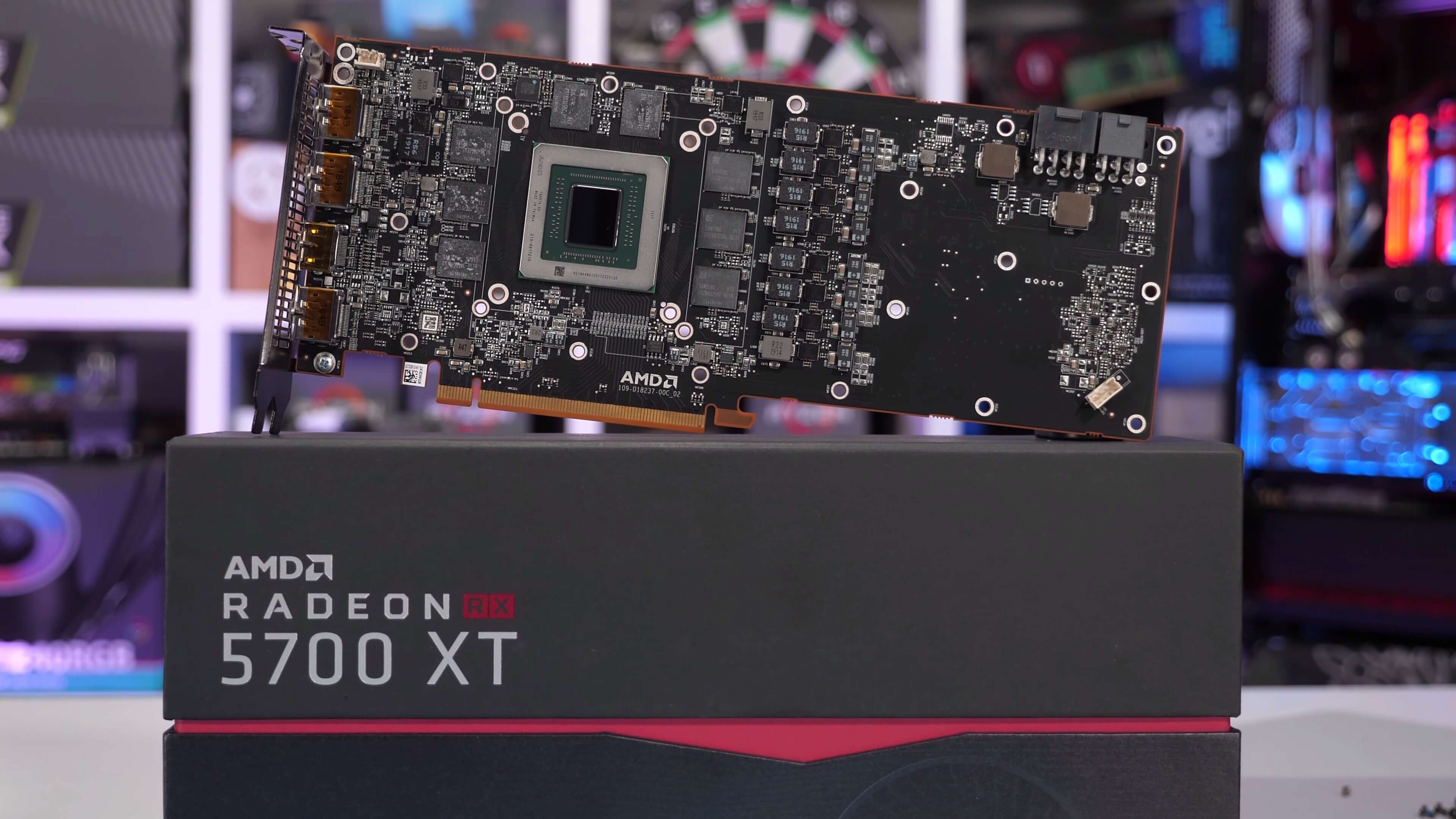














0 Response to "AMD Radeon RX 5700 XT and RX 5700 Review - TechSpot"
Post a Comment